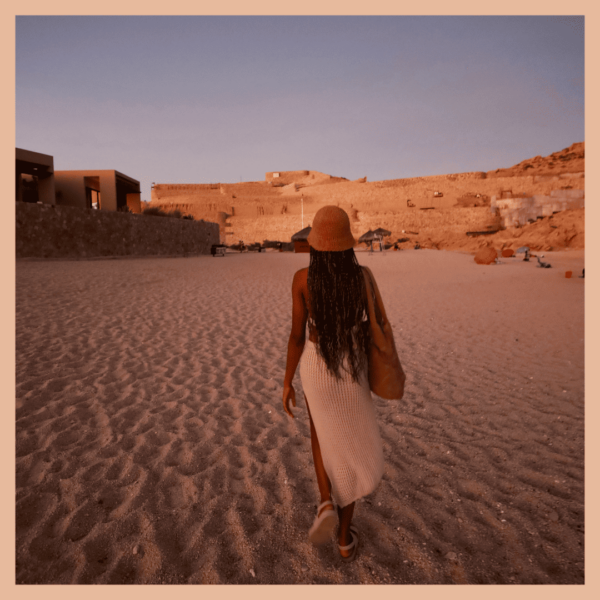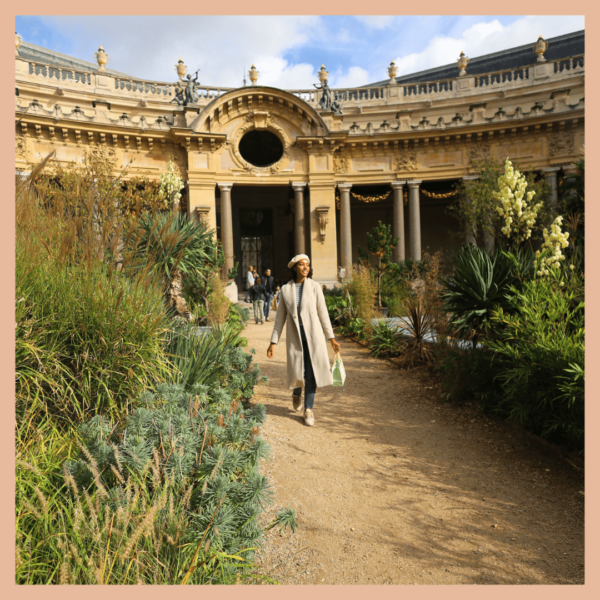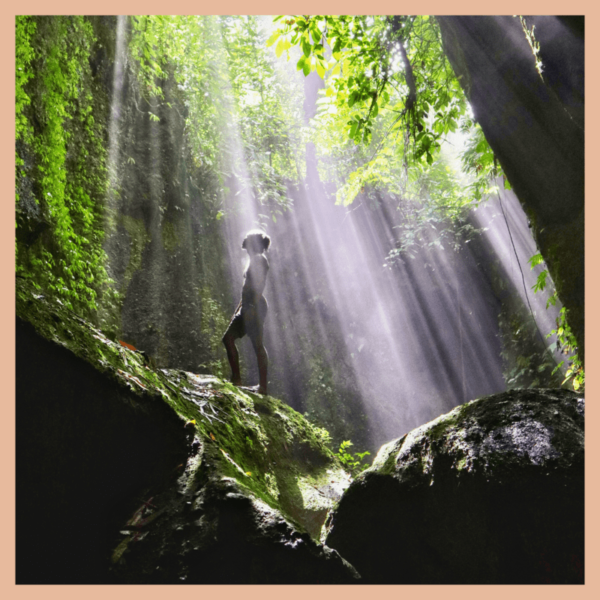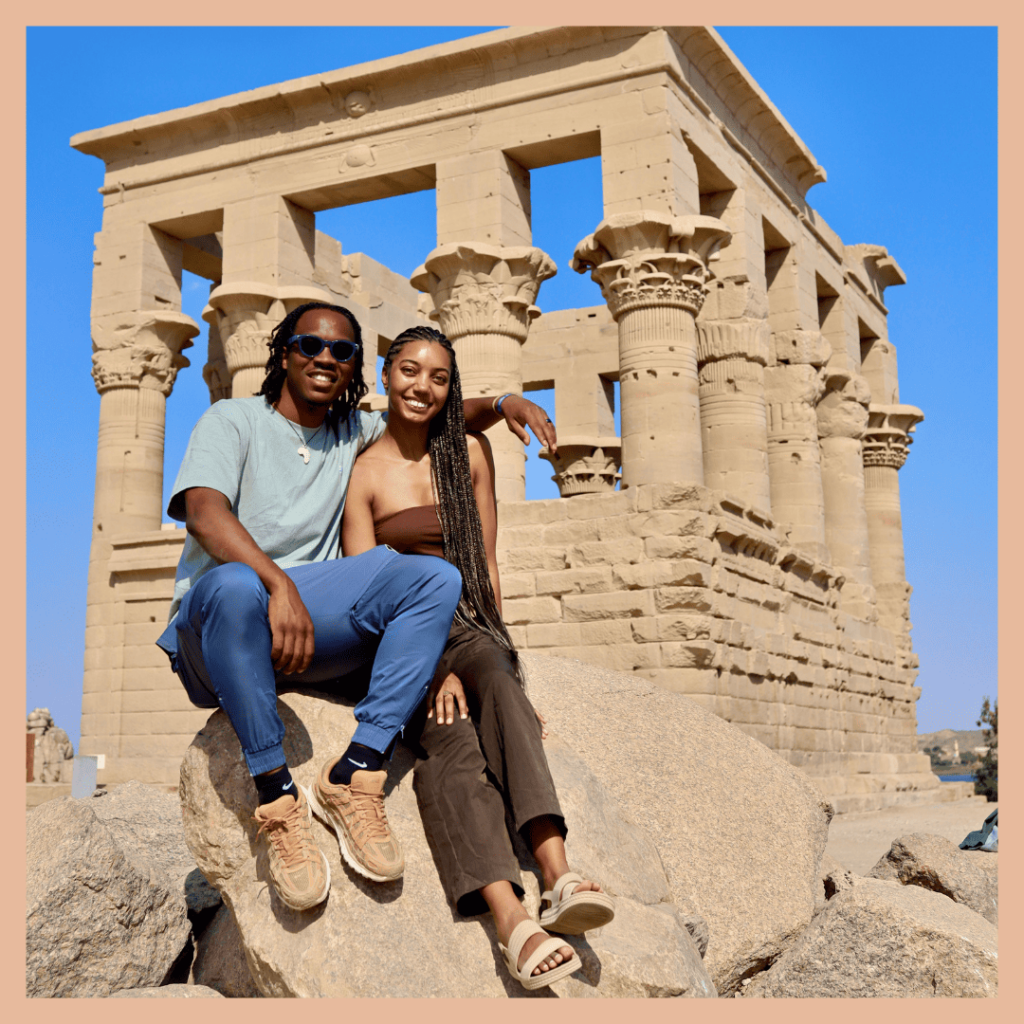
Need help planning a trip to Egypt? This 7-day itinerary covers the must-see sights and essential tips to help you make the most of your visit—from Cairo’s iconic pyramids to the temples of Luxor and Aswan. And if you’re wondering “What do things cost in Egypt?” we’re including the prices of everything along the way.
Disclosure: This post may contain affiliate links, which means we’ll receive a commission if you purchase through our links, at no extra cost to you. Please read full disclosure for more information.
If it’s your first time in Egypt, you’ll probably want to see the classic sites—and honestly, you should.
The Pyramids of Giza, the Nile River, and the Valley of the Kings are popular for good reason.
These are the kinds of places that make you pause and wonder how on earth did they build this?
They’re completely worth experiencing for yourself, no matter how many photos you’ve already seen.
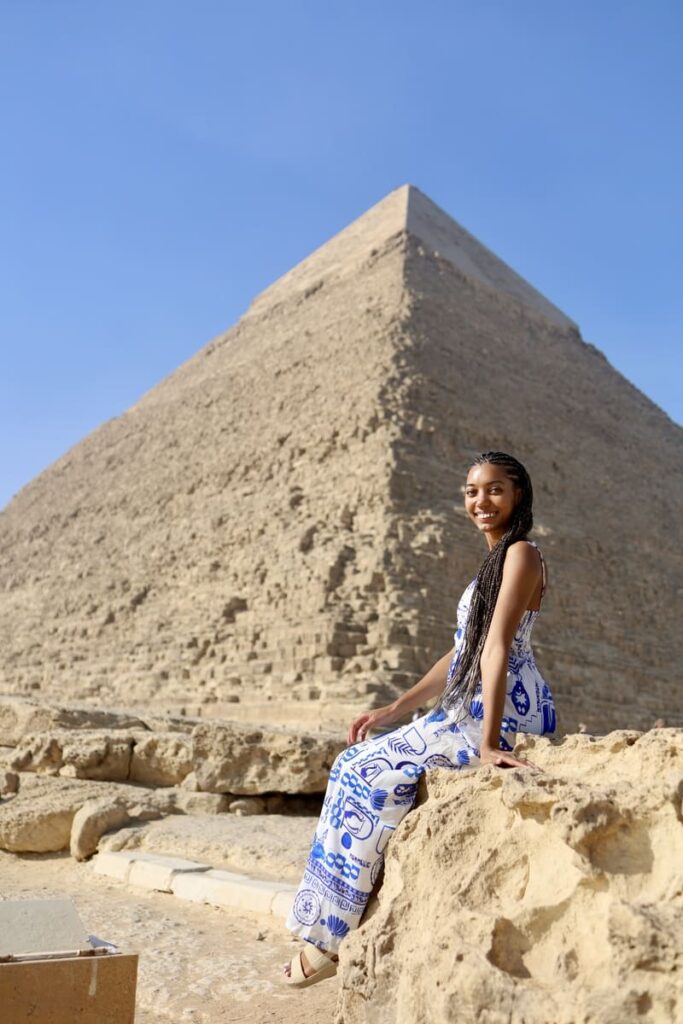
This 7-day Egypt itinerary is based on our own recent trip, covering the must-sees along with personal tips and lessons we learned along the way.
And while we packed a lot into one week, Egypt is massive—there’s no way to see it all in a single visit.
That’s why, at the end of this guide, we’ve included details on the places we’re already planning to explore next time.
Whether you’re trying to figure out how many days you really need in Egypt or deciding if one trip will be enough, this guide will help you make the most of your time.
Preview of the Egypt Itinerary:
- Day 1-2: Cairo & Giza
- Day 3-4: Luxor
- Day 5-6: Aswan & Nubian Village
- Day 7: Cairo & Departure
Let’s dive in!
Day 1: Cairo – Pyramids of Giza, Grand Egyptian Museum (GEM), and Akemi Egypt Restaurant
After landing at Cairo International Airport, we made our way through customs, which was pretty quick and straightforward.
As U.S. citizens, we paid $25 USD per person for a visa on arrival, which had to be in cash.
Before leaving the airport, we stopped at the ATM to grab some Egyptian pounds (EGP)—you’ll want cash on hand for tips (trust me, you’ll be tipping a lot) and random fees that pop up throughout the trip.
Cairo Airport Transport Tip: Once outside, we were immediately approached by drivers offering rides—some flashing their Uber app but really just trying to negotiate cash rates off the books. We skipped the hassle and used the Uber app directly, which was significantly cheaper. Our 20-minute ride to the hotel was 139 EGP (~$3 USD), while the drivers outside were quoting closer to $20 USD. Definitely worth using the app in Cairo to avoid getting overcharged.
After freshening up from the flight, we were ready to hit the ground running.
First stop? The Pyramids of Giza!
RELATED ARTICLE: What Can You Do on a 7 Hour Layover at Doha Airport?
The Pyramids of Giza
I’ll be honest—no photo or video fully captures what it’s like to stand in front of the pyramids.
I’ll actually never forget my first glimpse of them from the Uber. The sheer size and precision are mind-blowing.
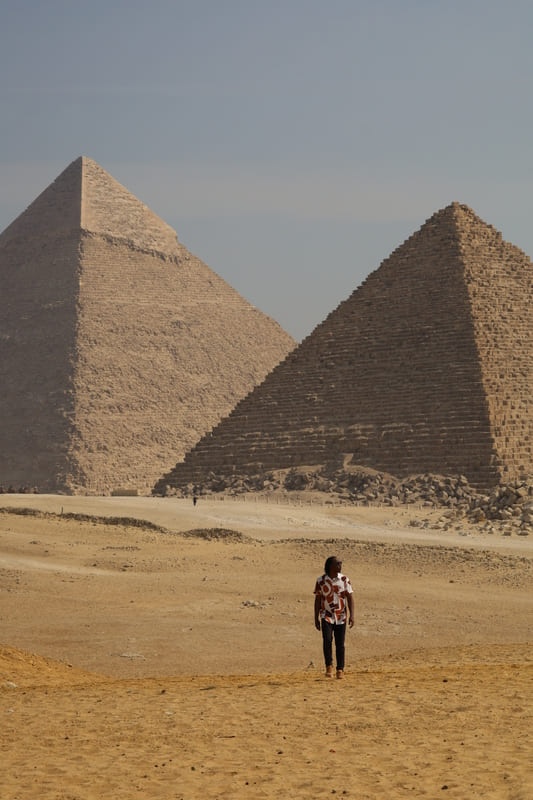
Chew Tip: We visited the pyramids twice and surprisingly, midday was less crowded than the early morning rush. Our 8 AM visit had heavy traffic and large tour groups, while our 1 PM visit was much more relaxed.
To start things off, we recommend heading to 9 Pyramids Lounge, a restaurant with panoramic views of all nine pyramids.
It’s worth making a reservation in advance—we booked about a week ahead.
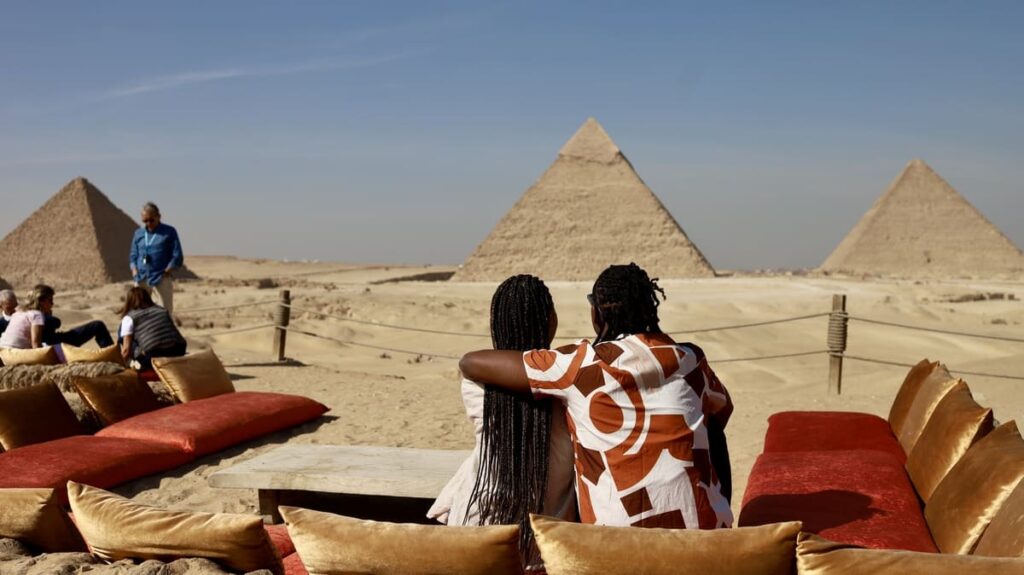
How It Works:
When you arrive at the complex, your driver will take you to the main entry where you’ll need to buy tickets for yourself, your driver, and their car.
- Entry fee: 750 EGP (~$15 USD) per adult. If you have a student ID, your entry fee will be discounted—definitely worth bringing along if you’re eligible.
- Local driver + car ticket: 80 EGP (~$1.60 USD) total
After purchasing the tickets (credit card only), you’ll give your driver their tickets and go through security with your own.
On the other side of security, you’ll meet your driver again, who will drive you up to the 9 Pyramids Lounge.
We were able to negotiate with our driver for 500 EGP (~$10 USD) to wait for us for two hours, then take us back to the main pyramids area afterward.
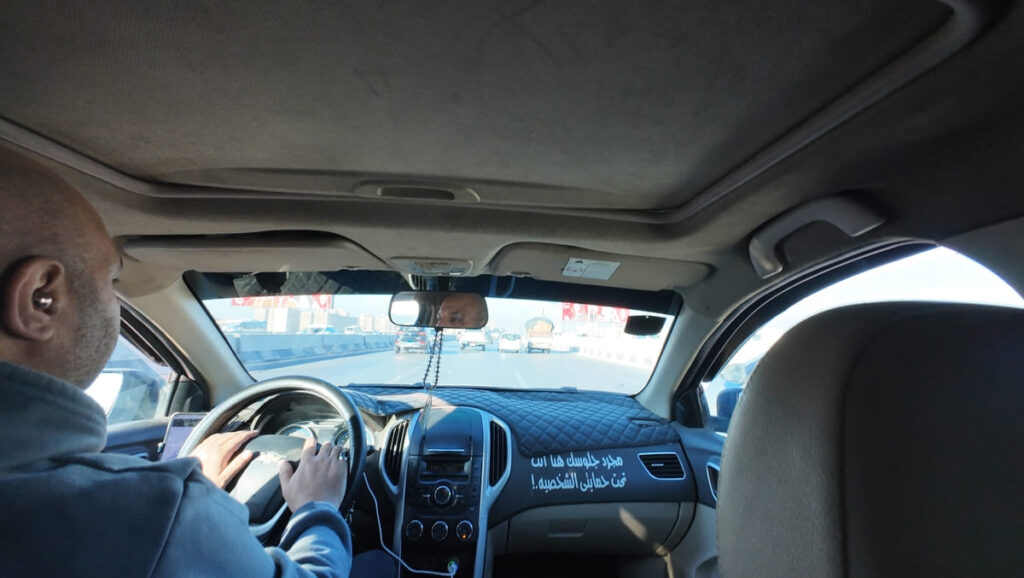
If you had a good experience with your driver, ask for their WhatsApp number. It’s helpful to have a reliable contact in case you have trouble finding an Uber later in your trip.
9 Pyramids Lounge
At 9 Pyramids Lounge, you’ll be treated to incredible panoramic views of all nine pyramids.
The restaurant serves traditional Egyptian dishes and is considered on the pricier side by local standards, but the view alone makes it worth it.
We ordered hummus, falafel, mixed vegetable tajin, beef raqqoq, fresh juices, and coffee.
Total cost: Our lunch for two came out to around 1400 EGP (~$27 USD).
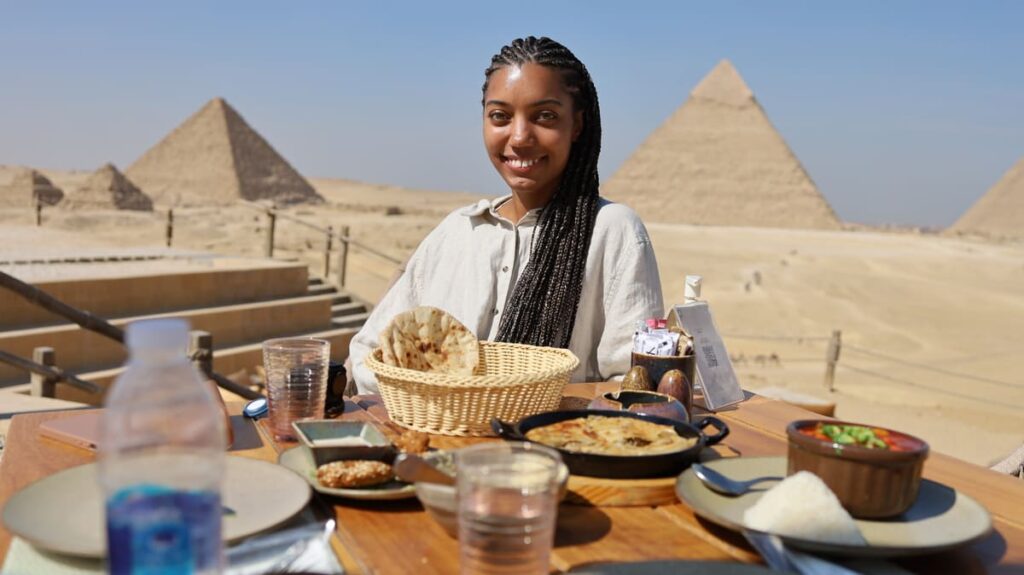
Great Sphinx of Giza
Once you’re well-fed and ready for some exploring, have your driver drop you off closer to the front entrance of the pyramids complex.
9 Pyramids Lounge is further out and not walkable to the pyramids—it’s just too far.
Chew Tip: If you leave the pyramids complex after visiting the lounge, security may require you to buy another entry ticket, claiming the original ticket only scans once. So, only leave the complex if you’re completely done seeing the pyramids.
Now is your time to really explore the pyramids and the Great Sphinx. You can go inside some pyramids for an additional cost of ~$5 USD per person.
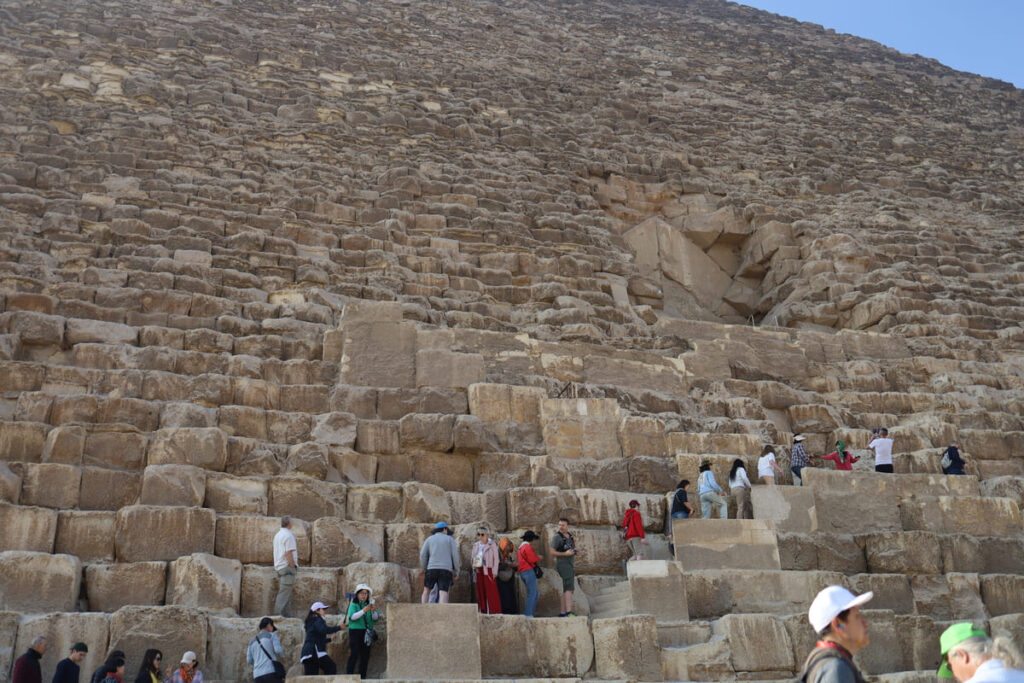
We spent a couple of hours wandering around the complex, stopping at the panoramic viewpoint for the classic shot of all the pyramids in one frame.
You can either walk the 1.5-hour round trip or opt for a camel or horse carriage ride.
We were quoted 500 EGP (~$10 USD) for a camel ride for two, but prices are always negotiable.
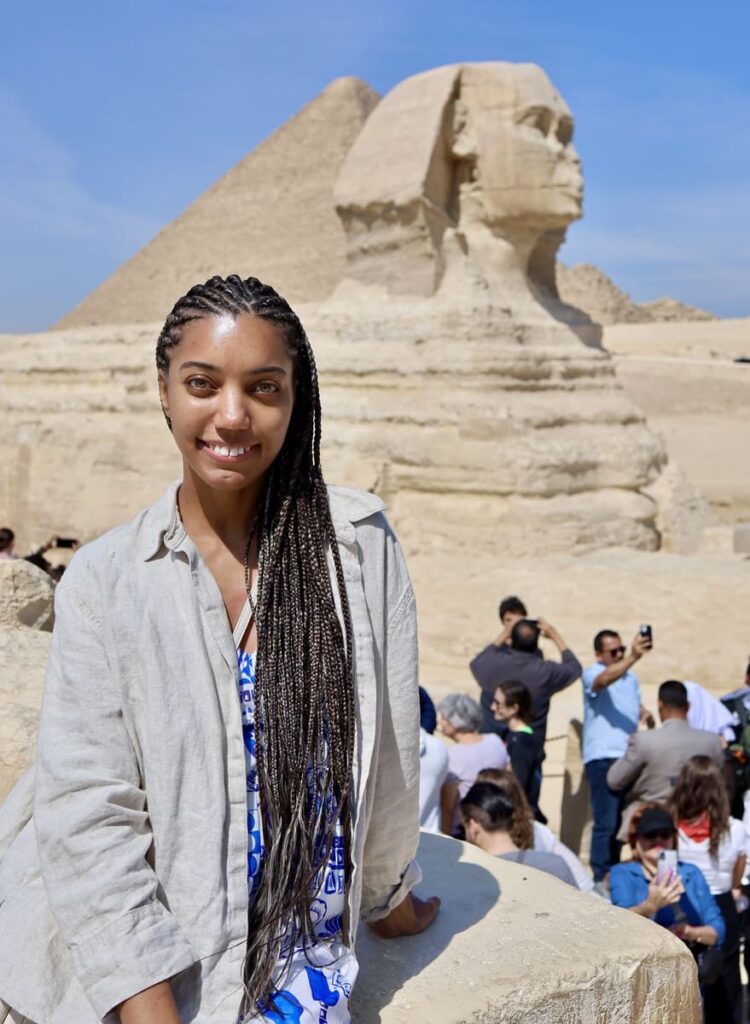
Grand Egyptian Museum (GEM)
The Grand Egyptian Museum (GEM) is not too far from the pyramids.
Tickets cost ~$25 USD per adult (1270 EGP) and need to be paid with a credit card.
It’s not fully open just yet, but even with a few exhibits still under construction, the museum does an incredible job blending ancient artifacts with modern, interactive displays.
The attention to detail is next-level, and the exhibits are thoughtfully presented.
We spent a couple of hours here and were thoroughly impressed.
Eventually, there’ll be a walkway built that connects the Great Pyramids with the Grand Egyptian Museum for even easier access.
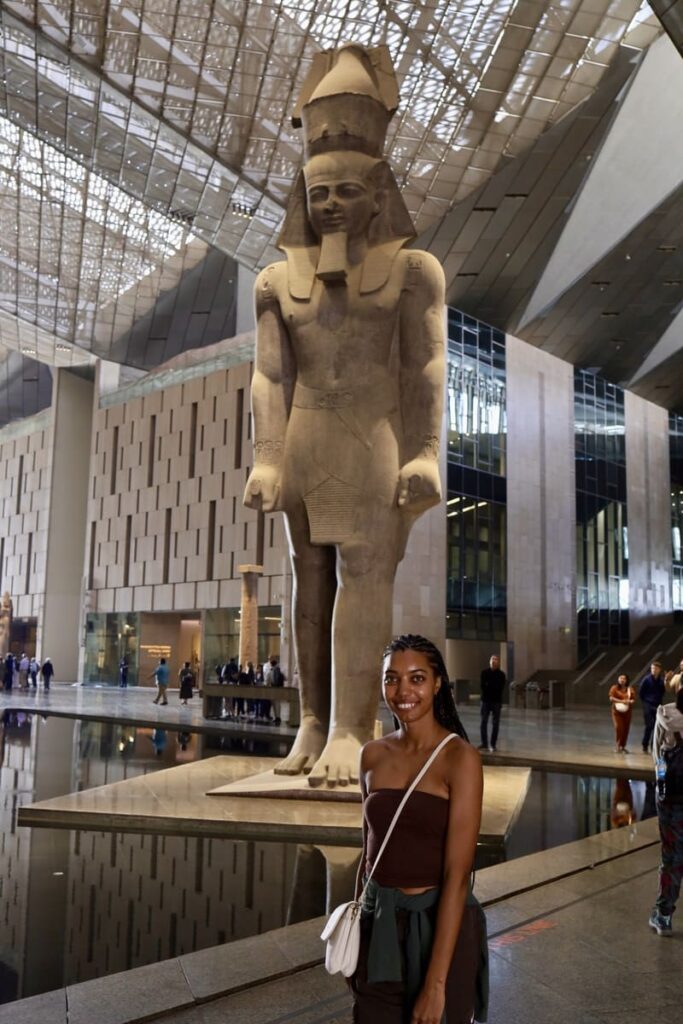
Dinner at Akemi Egypt
To end the day, we recommend having a rooftop dinner at Akemi Egypt Restaurant, conveniently located right across the street from the GEM.
You get a clear view of both the Great Pyramids and the museum, making it the perfect spot to unwind.
The food didn’t disappoint either. I had the lentil soup and penne arrabbiata with a mango beach drink, while my husband ordered the dynamite shrimp and chicken cream soup.
Everything was fresh, flavorful, and well-seasoned.
Total cost: Our meal came out to around 1400 EGP (~$29 USD), which was more than fair for the quality and the view.
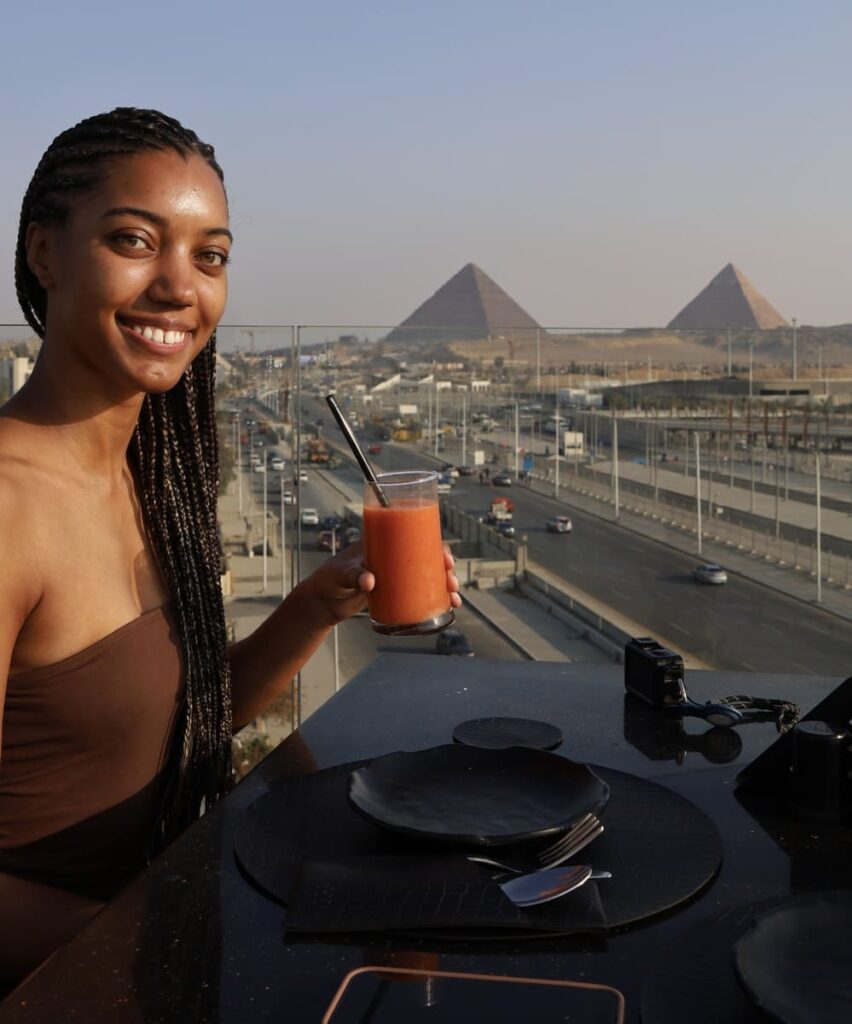
RELATED ARTICLE: What Do You Need to Know Before Traveling to Egypt?
Day 2: Cairo – Khan El Khalili Market, Al Azhar Mosque, and Aroka Healing Center
Today, fuel up with breakfast at your accommodation before heading out.
If you’re still booking your stay, it’s worth choosing a place with breakfast included—it’ll save you time and money.
Plus, you’ll need the energy for what’s ahead, because today is all about diving into Old Cairo.
Khan El Khalili Market
From the Giza area, it’s about 30-40 minutes by car to reach Khan El Khalili Bazaar in Old Cairo.
This historic market is known as a must-visit for most tourists—and while I wouldn’t personally revisit it, it’s probably an experience you should have at least once.
Because, did you even go to Cairo if you didn’t get pressured into buying that thing you never knew you needed?
Chew Tip: Bring plenty of small Egyptian bills. Having smaller bills can save you from getting shorted.
We came to Khan El Khalili with one goal—to find traditional Egyptian outfits.
We each found exactly what we were looking for:
- My outfit: 500 EGP (~$10 USD)
- My husband’s outfit: 650 EGP (~$13 USD)
We were happy with the prices—definitely a good deal for authentic pieces. But once the locals saw us make a purchase, it was game on.
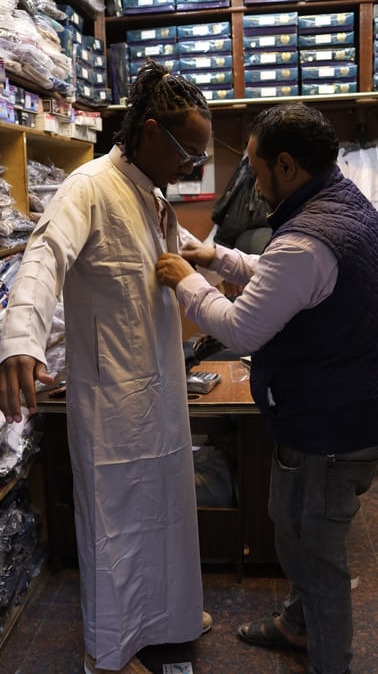
While paying, a man approached us, asking us to visit his shop around the corner.
He claimed he just wanted us to take his card and recommend him to our friends.
Seemed harmless enough, right? But it really wasn’t.
The next thing we knew, we were sitting in his oils shop with him blocking the door and pouring oil samples for us.
Don’t get me wrong—the oils smelled incredible, but we weren’t in the market for any.
Still, leaving wasn’t so easy.
For 30 minutes, he had us bargaining over oils we didn’t even want, quoting $200 USD for two travel-sized bottles.
Since we travel on a budget, we were firm with low offers, expecting him to let us just walk away. Instead, he kept circling back, relentlessly trying to make the sale.
Eventually, my husband offered $30 USD for one bottle, just to end the conversation. To our surprise, he agreed—but while wrapping it up, he charged our card $40 USD instead.
If that wasn’t enough, he threw a second bottle into our bag and then said, “Just $25 more, no problem!”
At that point, we firmly handed the second bottle back and finally made our escape.
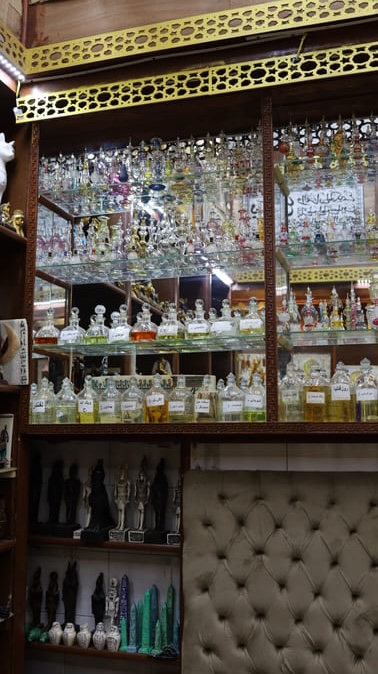
If you’re planning to visit Khan El Khalili, here’s my advice:
- Stay focused – Know what you came for and stick to it. Browse quickly, buy what you want, and move on.
- Don’t follow anyone into a shop unless you genuinely intend to buy.
- Be firm and polite – “La shukran” (no, thank you) works best—repeat it confidently if needed.
- Walk away if you’re not interested – It’s easy to get cornered in a shop, so avoid going inside if you’re unsure.
Al Azhar Mosque
After the chaotic market scene, you’ll probably want to slow things down—and Al Azhar Mosque is the perfect place to do just that.
Located just a few blocks from Khan El Khalili, this historic mosque dates back to 970 AD and is one of the most important Islamic sites in Cairo.
Even if you’re not religious, it’s worth visiting for its stunning architecture and peaceful ambiance.
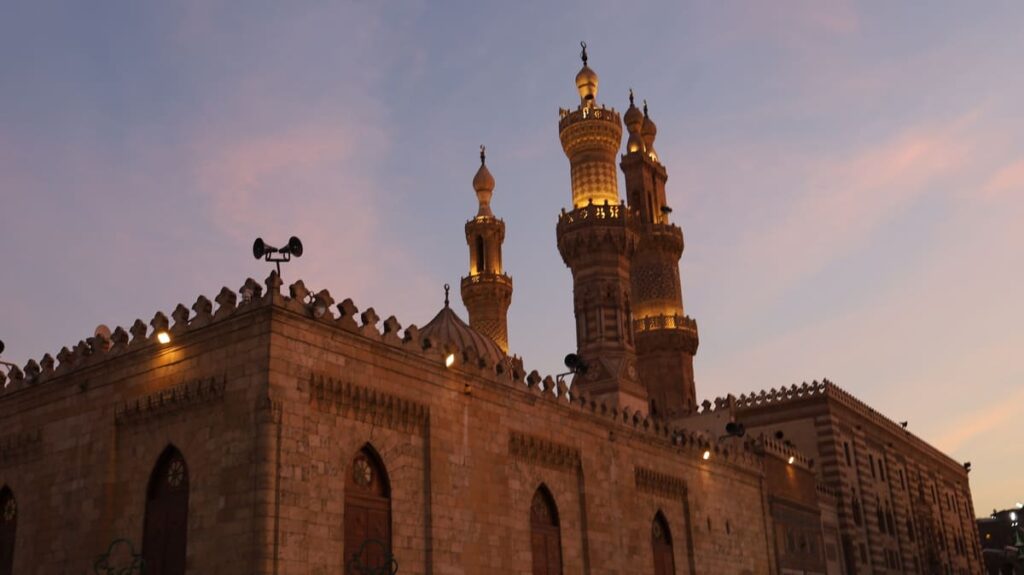
Chew Tip: Dress modestly to respect local customs. Men: Wear long, loose pants and shirts covering the arms and shoulders. Women: Keep your chest, shoulders, and knees covered. While head coverings aren’t required, they are welcomed.
RELATED ARTICLE: How to Take the Cable Car Up Table Mountain
Local Egyptian Food
By now, you’ll probably be ready for a meal.
Walk a few blocks from the mosque, and you’ll find plenty of local restaurants serving authentic Egyptian food at budget-friendly prices.
My husband grabbed a sandwich for only about 200 EGP (~$4 USD).
If you’re after a quick and casual meal, this area is perfect.
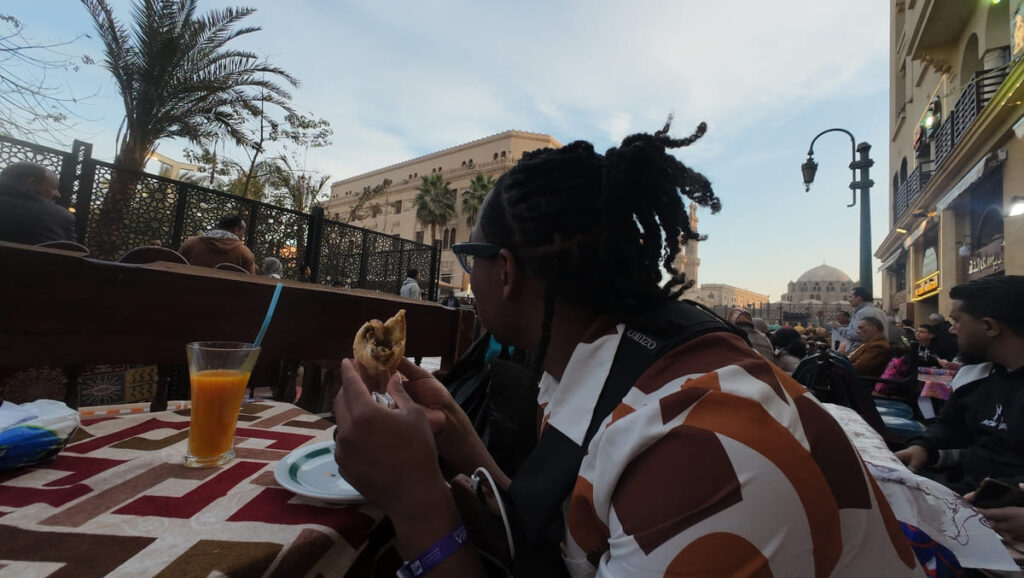
Aroka Healing Center
After a day of market bargaining and sightseeing, you might as well treat yourself to some relaxation.
Head to Aroka Healing Center in Maadi—a calm, upscale neighborhood—for a much-needed massage.
This wellness center offers a range of treatments, including deep tissue and relaxation massages. A 60-minute aromatherapy massage costs about $30 USD.
The last appointment is at 9 PM, so it’s perfect for winding down after a long day.
Just be sure to book in advance since they can fill up quickly.
Vegan at Our House
Maadi offers plenty of great dining options, but if you’re looking for something plant-based, Vegan at Our House is a top choice.
This vegan-friendly spot serves delicious burgers, soups, sandwiches, pastas, and salads—all at budget-friendly prices.
You can enjoy a full meal for under $10 USD per person.
RELATED ARTICLE: One Week in the Seychelles
Day 3: Overnight Bus to Luxor, Temples Tour & Nile River Sunset
Overnight Bus from Cairo to Luxor
As budget travelers, the overnight bus was the best way for us to get from Cairo to Luxor Egypt.
It’s significantly cheaper than the train or a flight and saves you both money and a night of accommodation.
We booked with GoBus, which offers a comfortable coach-style bus with reclining seats.
Our tickets were only 200 EGP (~$6 USD) per person, compared to $90+ USD per person for the train, which takes just as long (~10 hours).
The ride was smooth, with a few rest stops along the way.
However, be prepared for:
- Squatty potties – Restroom facilities were basic. Think a hole in the ground with a bucket under a faucet. If the bucket isn’t full, you’ll need to fill it with water to pour it down the hole to “flush.”
- Pay-to-use restrooms – It costs about 3 EGP (~$0.10 USD) to use the restrooms. Many attendants don’t have change, so it’s useful to have some coins.
- Bring your own hygiene essentials – No soap or toilet paper at some of the rest stops, so bring your own tissues, hand sanitizer, and soap.
RELATED ARTICLE: How to Spend 3 Days in Cape Town
Arrival in Luxor – No Rideshares, Only Taxis
We arrived in Luxor at 9 AM, only to discover that Uber and other rideshare services don’t exist here.
With no rides available, we had to go the old-fashioned route—taxis.
As soon as we stepped off the bus, drivers swarmed us, offering rides at inflated prices.
So, we walked about 5 minutes away from the bus stop and found a driver willing to negotiate.
We paid 150 EGP (~$3 USD) for the 10-minute ride to our hotel, which was the Hilton Luxor Resort & Spa.
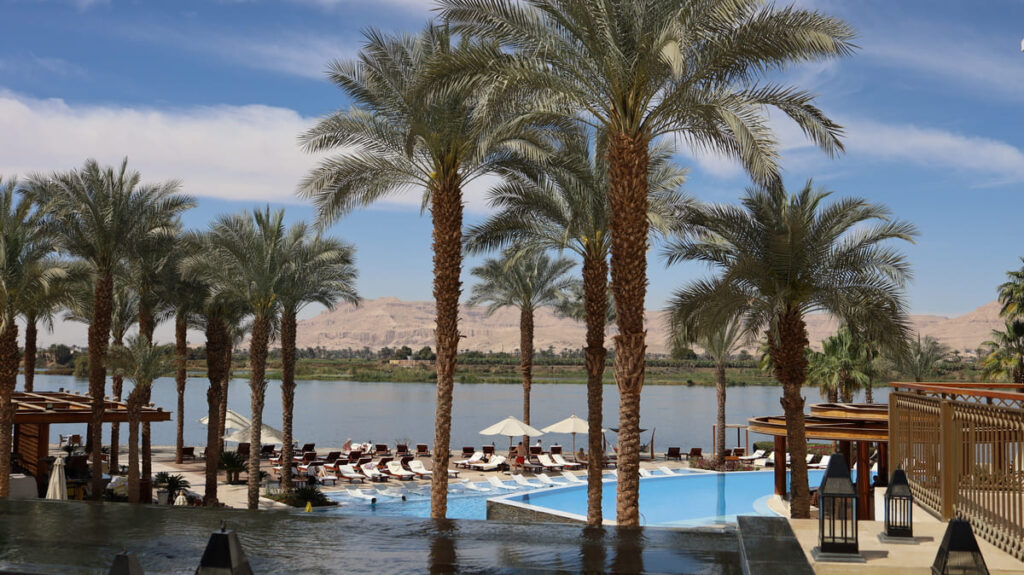
RELATED ARTICLE: Luxor Things to Do
Hilton Luxor Resort & Spa
The Hilton Luxor was easily one of the best hotels we stayed at in Egypt.
It’s located right on the Nile River, offering stunning views, luxurious amenities, and impeccable service.
What we loved:
- Infinity pools overlooking the Nile
- Three bars and three restaurants on-site
- Spacious rooms with Nile views and plush bedding
- Peaceful atmosphere—a welcome escape from the city
We arrived just in time for the hotel’s breakfast buffet, which runs from 6 AM to 11 AM.
The spread was impressive, offering a variety of local and international dishes.
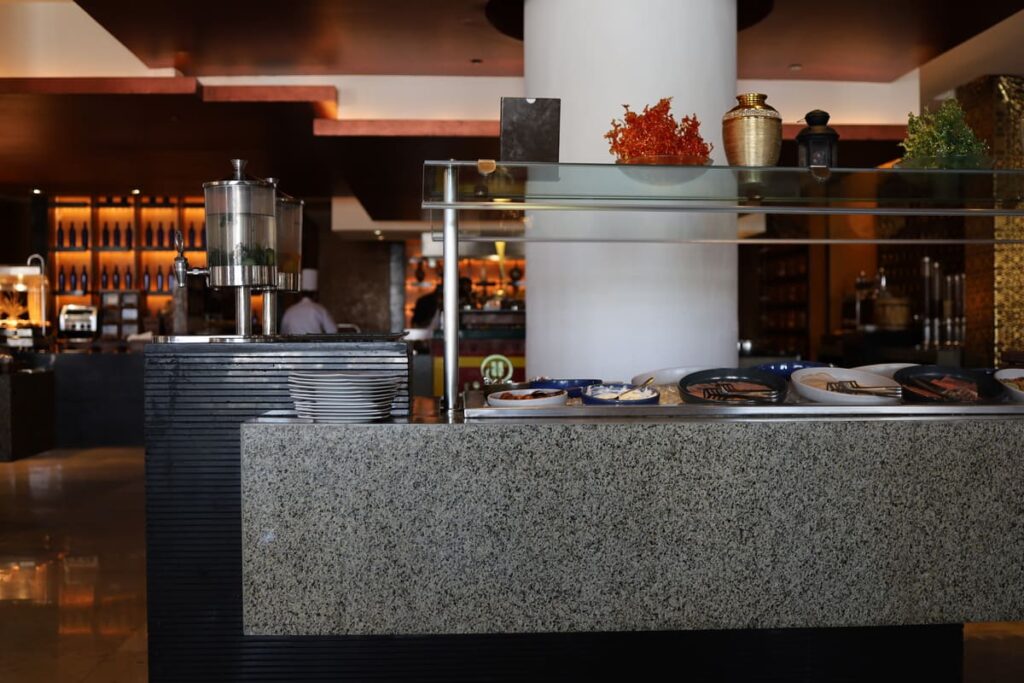
Here’s what we enjoyed the most:
- Freshly squeezed orange juice – Some of the best we’ve ever had.
- Sugarcane juice – A sweet, local specialty worth trying.
- Crepe station – The friendly chef whipped up custom crepes with sweet or savory fillings.
- I kept mine simple with bananas and caramel.
- My husband went for bananas with Nutella.
- I kept mine simple with bananas and caramel.
Chew Tip: If you’re staying at Hilton Luxor Resort & Spa, take your time with breakfast—the relaxed vibe and river views are worth savoring.
Before heading out to explore, we relaxed by the pool.
The Nile River views were so peaceful, and the infinity pool made it feel like we were swimming right into the horizon.
If you have time, take a quick dip or lounge with a drink in hand—it’s the perfect way to recharge before sightseeing.
Getting Around Luxor
Right outside the hotel, you’ll find taxi drivers waiting. The concierge can arrange taxis for you, but the rates tend to be higher.
Instead, we walked outside the resort complex, past security, and crossed the street.
That’s where we met Ahmed, a trustworthy, friendly driver who offered us affordable rates throughout Luxor.
- Ride to Luxor Temple: 100 EGP (~$2 USD)
- Initial quote was ~500 EGP from other drivers, but Ahmed agreed to 100 EGP after negotiating.
Chew Tip: Walking a few minutes away from hotels often helps you find more affordable taxis.
Luxor Temple
Our first stop was Luxor Temple, a massive, ancient complex that’s absolutely breathtaking.
- Entry Fee: ~$10 USD. Card only, no cash payments accepted.
- Time needed: Around 45-60 minutes to explore thoroughly.
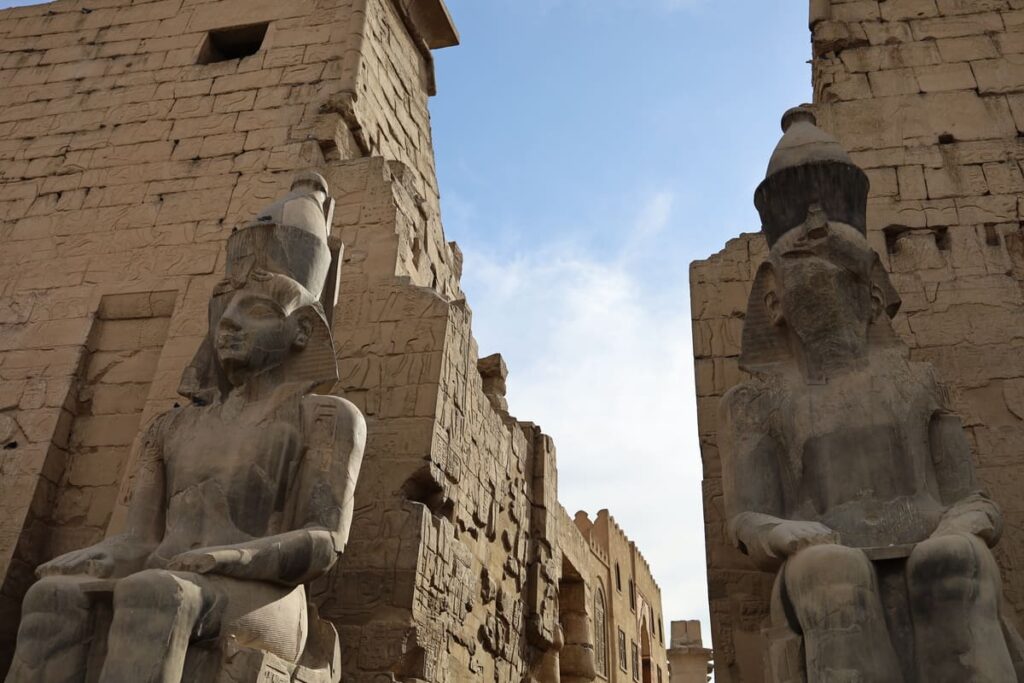
What makes it special:
- Towering columns and obelisks – The sheer size and scale are unbelievable.
- Intricate hieroglyphics – Each symbol tells a story carved in stone.
- Historical significance – Built around 1400 BC, it’s one of the most important temples in ancient Egyptian history.
It’s hard not to wonder, “How did they build something this massive, this detailed, so long ago?”
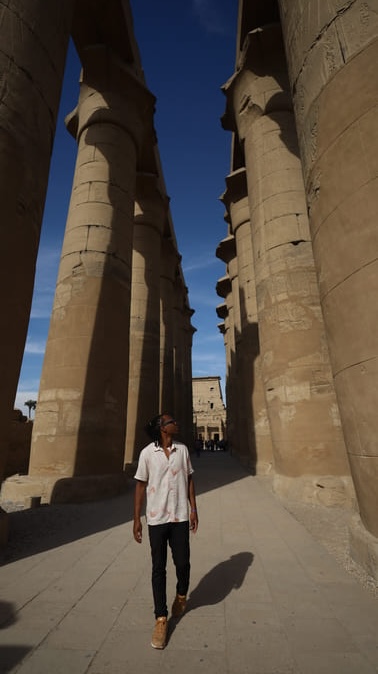
Avenue of Sphinxes
After Luxor Temple, we walked along the Avenue of Sphinxes, a 1.7 mile (2.7 km) path lined with sphinxes that once connected Luxor Temple with Karnak Temple.
The walk took about 30 minutes, and surprisingly, we were the only ones walking along it—most tourists go for a taxi or carriage.
As you approach Karnak Temple, you’ll pass a ticket office where you need to pay ~$12 USD per person for entry to continue on.
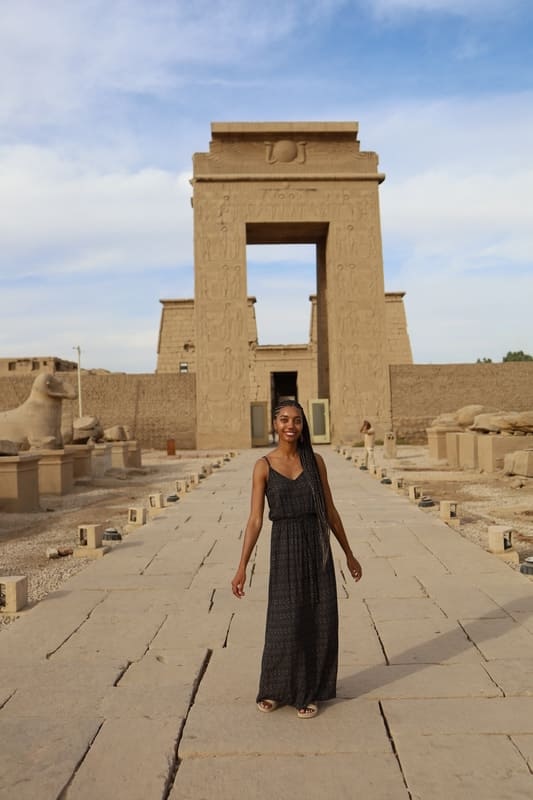
Karnak Temple
Next up: Karnak Temple, which was even more impressive than Luxor Temple.
It’s larger, grander, and more intricate—easily my favorite.
Despite the crowds, the temple is so large that you can find quiet corners to admire on your own.
Many locals and security guards will offer to unlock secret areas, show you around, or take your photos.
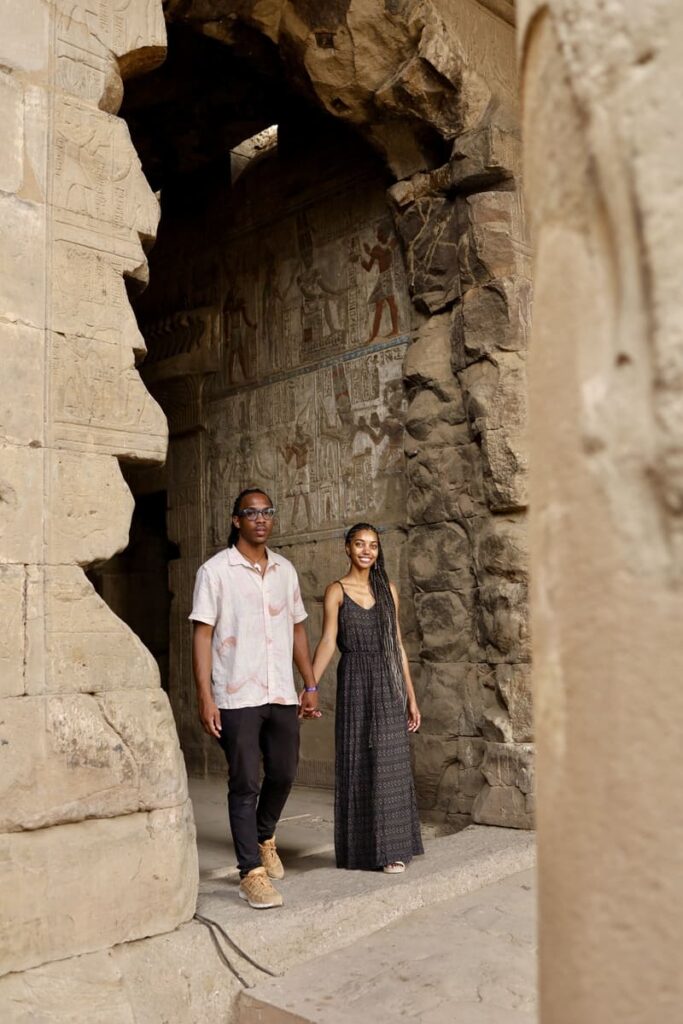
They’ll expect a tip, so carry small bills (10-20 EGP) if you want to accept their offers.
Don’t feel obligated—you can politely decline if you prefer to explore on your own.
We spent about 45 minutes at Karnak, but you could easily stay longer—it’s enormous.
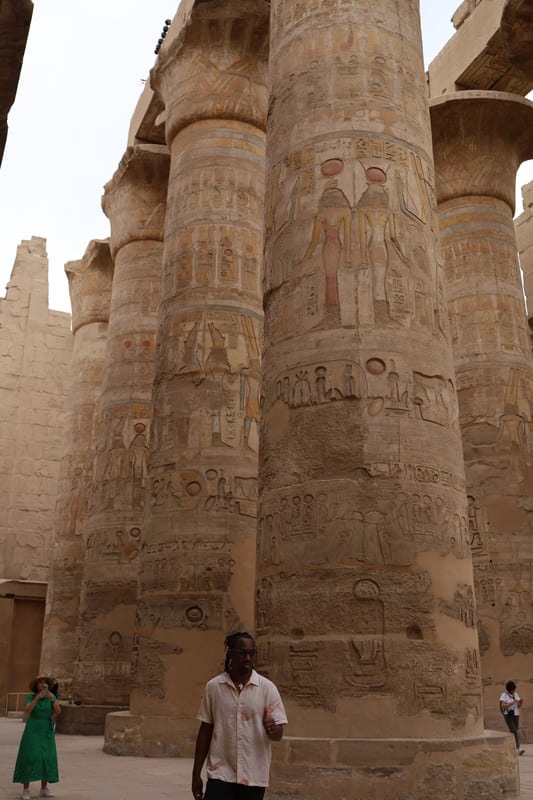
Nile River Sunset & Happy Hour
After exploring the temples, we returned to the Hilton to unwind by the pool during happy hour.
Watching the sunset over the Nile was pure magic. The sky turned shades of hot pink and orange, reflecting off the water.
It was one of the most beautiful sunsets we’ve ever seen.
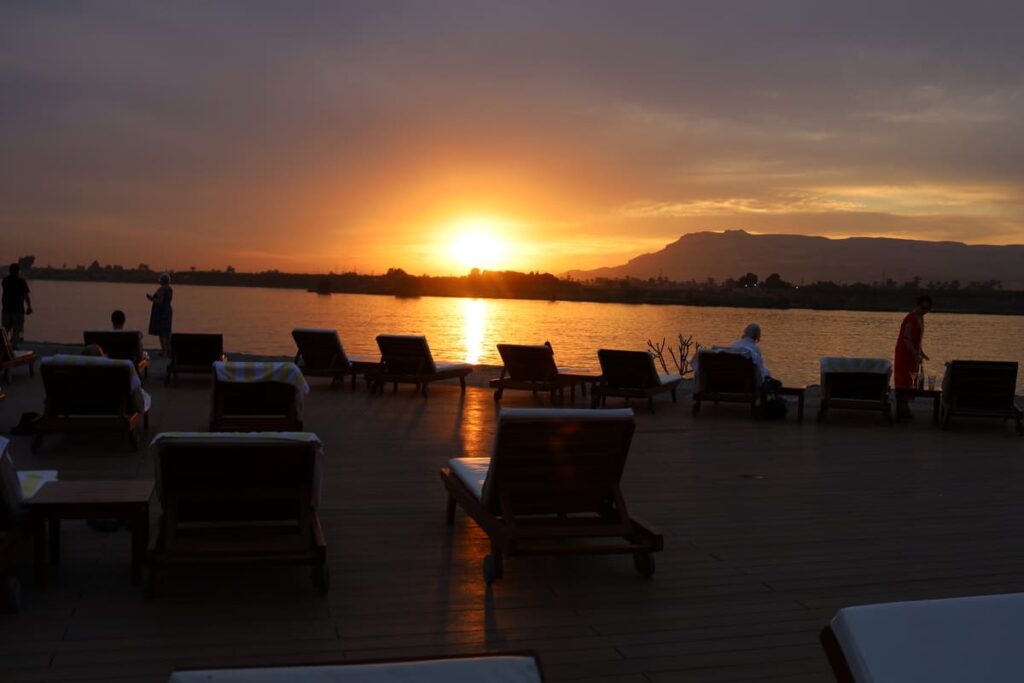
Dinner at Olives
For dinner, we ate at Olives, Hilton’s Mediterranean restaurant by the pool.
Here’s what we ordered:
- Mushroom risotto – Rich, creamy, and flavorful.
- Kosheri – My favorite vegetarian dish in Egypt. A mix of noodles, lentils, chickpeas, fried onions, and red sauce. Absolutely delicious.
- Sea bass – My husband’s dish, perfectly cooked and seasoned.
- Juniper Essence cocktail – A bit too sweet for my taste, but still refreshing.
Cost: Our entire dinner for two came out to around $30 USD.
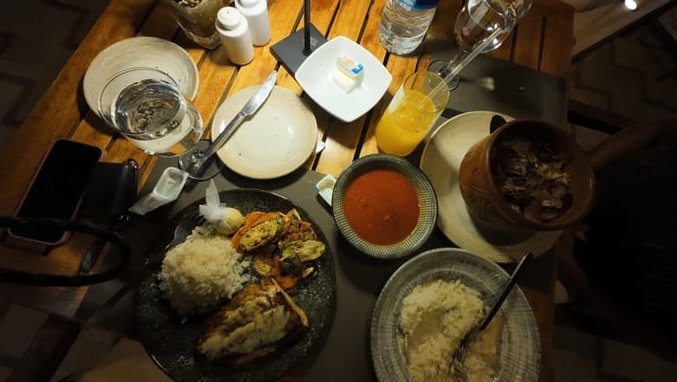
RELATED ARTICLE: Where to Visit in Mahe, Seychelles
RELATED ARTICLE: How Many Days Do You Need in Mahe, Seychelles?
Day 4: Luxor – Valley of the Kings, Hatshepsut Temple, Medinet Habu, Colossi of Memnon & Felucca Ride
Valley of the Kings
Start your day early with a visit to the Valley of the Kings, one of Egypt’s most iconic archaeological sites that costs ~$15 USD per person to enter. (Cheaper if you have your student ID with you.)
This necropolis was intended to be the final resting place of many ancient Egyptian pharaohs, including King Tut.
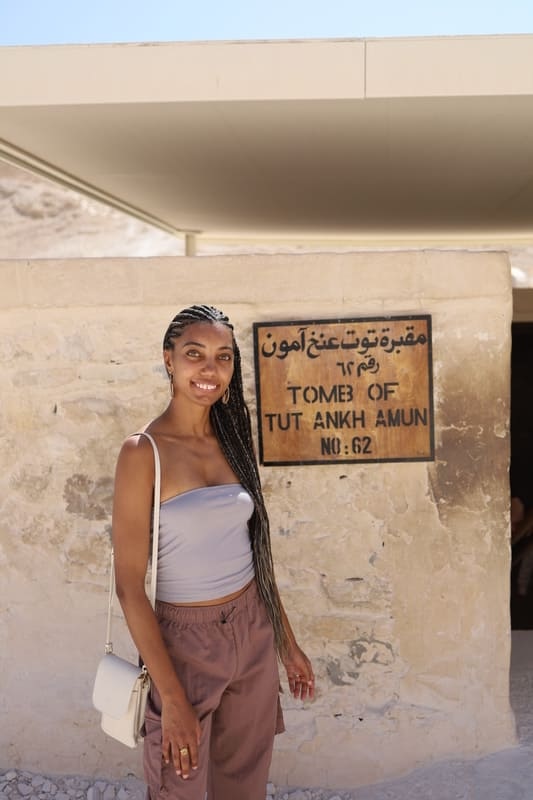
Important Tips:
- No shade, lots of walking – Wear sunscreen, a hat, and comfortable shoes.
- Restrooms and seating areas are available, along with a small shop selling drinks, snacks, and souvenirs.
- Entry ticket includes access to 3 tombs, but you can pay extra for certain tombs.
The first tomb near the entrance tends to be the most crowded.
Walk further down the site for less busy tombs. We had some of them entirely to ourselves.
You’ll encounter local guides inside the tombs offering to take photos of you or share additional historical facts.
They expect tips, so keep small bills (10-20 EGP) handy.
The tombs themselves are so special to visit. The walls and ceilings are adorned with vibrant hieroglyphics and symbolic artwork, many still vividly preserved.
It’s fascinating to see the stone sarcophagi in which the pharaohs were once buried.
Some of the tombs are surprisingly large, with long passageways leading to the burial chambers.
We chose to pay extra for one additional tomb (Ramses V & VI), and it was worth it.
The fewer crowds and stunning details made it a highlight.
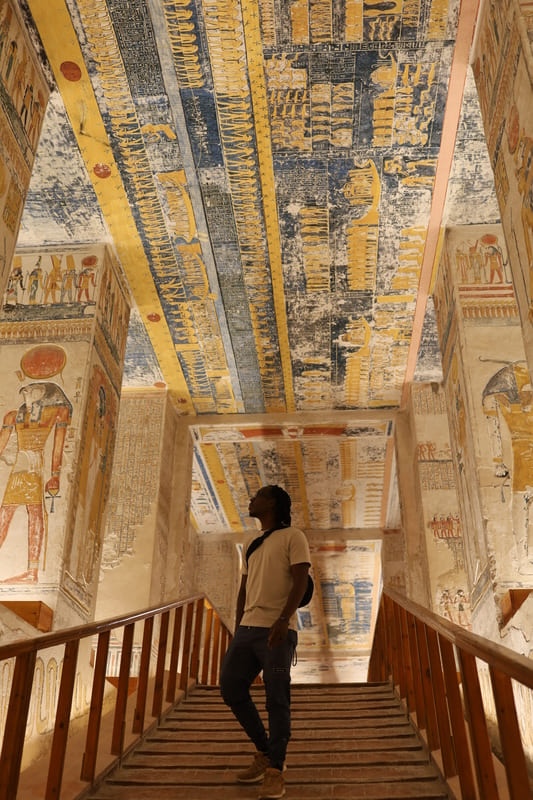
Hatshepsut Temple
Next, head to the nearby Hatshepsut Temple, one of Egypt’s most famous mortuary temples which cost ~$8 USD per person to enter.
Built for Queen Hatshepsut, one of the few female pharaohs, this temple is known for its colossal terraces and grand architecture.
The temple is built into the base of towering cliffs, making for a beautifully dramatic setting.
Much of the temple was defaced and destroyed after Hatshepsut’s death, but you can still admire the impressive statues and remnants of what it used to be.
Despite the damage, some of the carvings and inscriptions remain remarkably well-preserved.
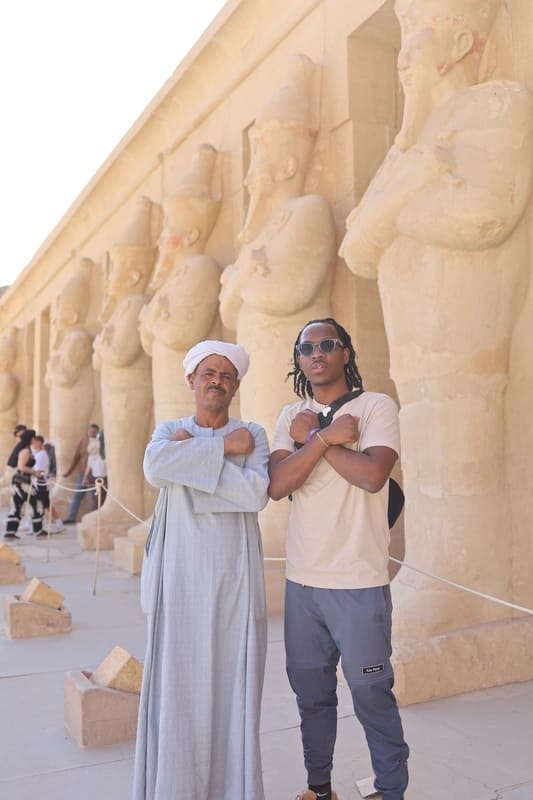
Medinet Habu
Our next stop was Medinet Habu, and to our surprise, it ended up being one of our favorite sites of the day.
The massive complex features towering columns, detailed carvings, and colorful hieroglyphics that cost only ~$4 USD per person to enter.
Compared to the more famous temples, Medinet Habu felt peaceful and less busy.
The colors and carvings are still vivid and detailed, making it feel almost untouched by time.
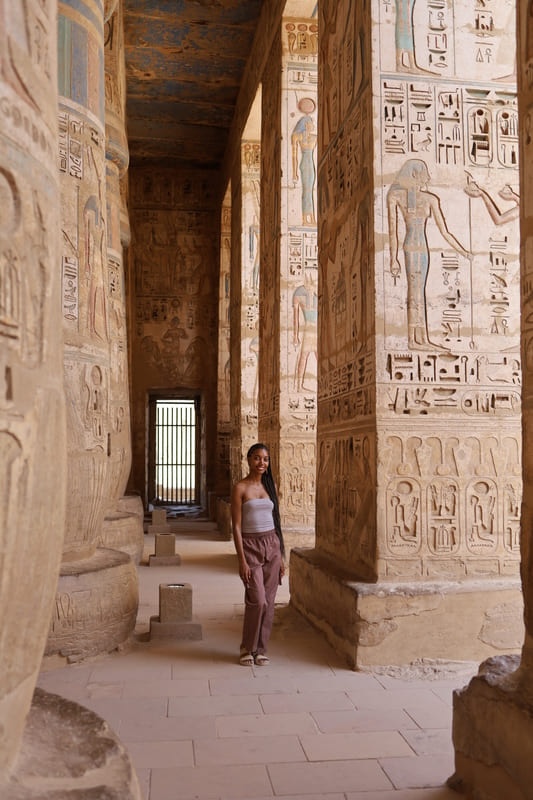
Chew Tip: This temple is less touristy, which makes it a great place for photos without the crowds. If you enjoy ancient architecture and vivid hieroglyphics, you’ll love this stop.
Colossi of Memnon
Before heading back, stop by the Colossi of Memnon, a free attraction located in the same general area.
These two massive stone statues depict Pharaoh Amenhotep III and stand over 60 feet tall.
There’s no entrance fee, and you’ll only need about 10 minutes here. It’s a quick stop.
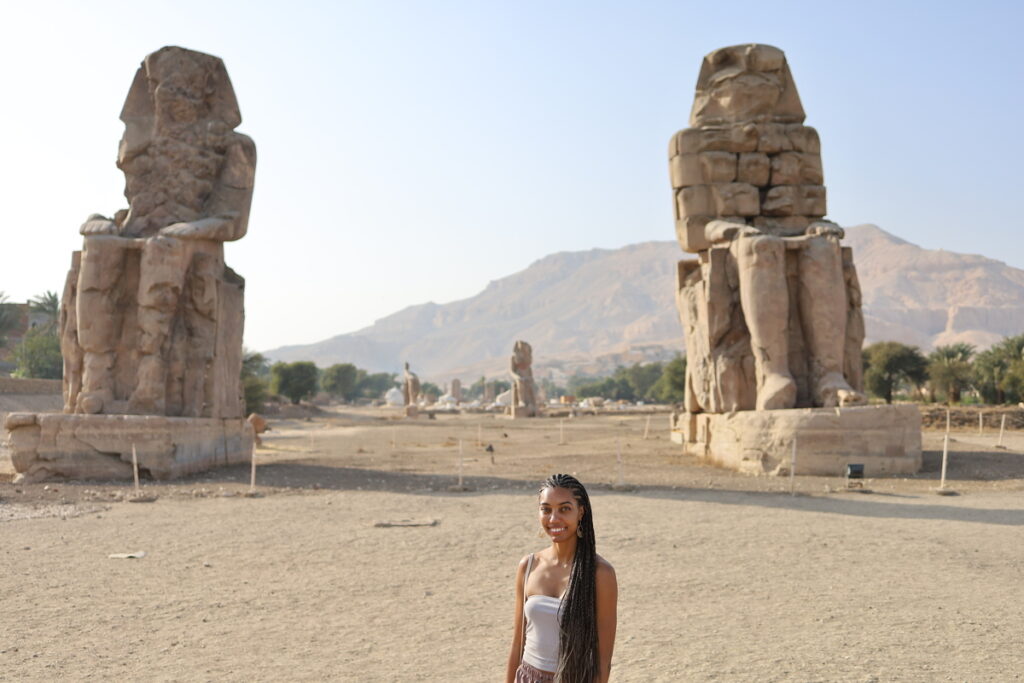
Al Sahaby Lane Restaurant
Located on a rooftop overlooking the Avenue of Sphinxes, Al Sahaby Lane offers a beautiful dining experience with traditional Egyptian dishes.
Be prepared to climb a lot of stairs—there was no elevator access during our visit.
They have different curries, vegetarian and seafood options. A meal for the two of us came out to ~$19 USD.
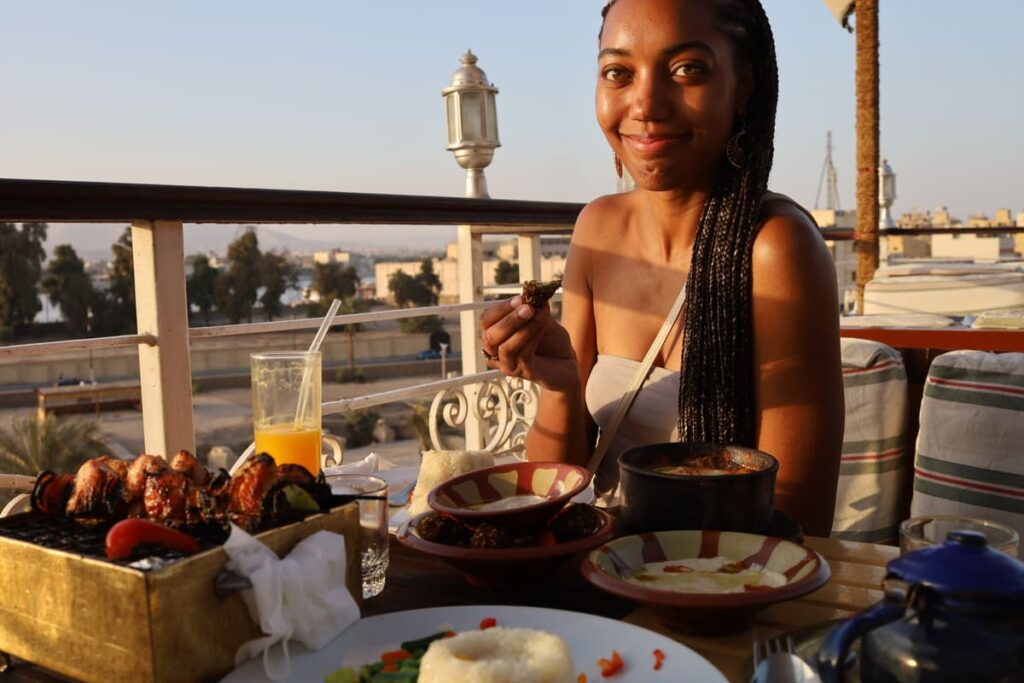
Sunset Felucca Ride on the Nile River
After a busy day of sightseeing, a felucca ride on the Nile is a great way to wind down.
We paid 650 EGP (~$14 USD) for a private, one-hour ride.
It’s a peaceful experience, but be aware that some boat operators may start with a high price—don’t be afraid to negotiate.
The temperature can drop quickly after sunset, so bringing a light jacket is a good idea.
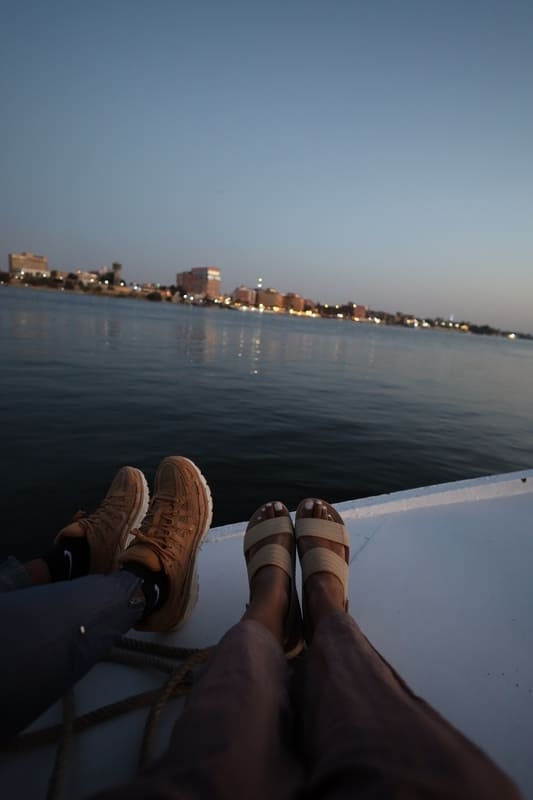
Dinner at Silk Road
Back at the Hilton Luxor, we wrapped up the evening with dinner at Silk Road, their Asian-inspired restaurant.
Here’s what we ordered:
- Stir-fried noodles – Perfectly seasoned and flavorful.
- Thai curry – Rich, creamy, and mildly spicy.
- Fried rice – Simple but well-prepared and filling.
It cost around $35 USD for two people, which was affordable considering the quality and resort setting.
RELATED ARTICLE: Which Part of Seychelles Has the Best Beaches?
RELATED ARTICLE: How Many Days Do You Need in La Digue Seychelles?
Day 5: Luxor Hot Air Balloon Ride & Nubian Village in Aswan
Hot Air Balloon Ride Over Luxor
Our day started bright and early at 5:30 AM with a pickup from the Hilton Luxor Resort for a hot air balloon ride.
While this definitely isn’t the only place in the world you can do it (we’ve done balloon rides in Mexico City for around $200 USD per person, and we’ve seen them offered in Masai Mara for $450 USD and Turkiye for $300 USD), Luxor was by far the most affordable—just $30 USD per person.
Honestly, that price alone made it a no-brainer.
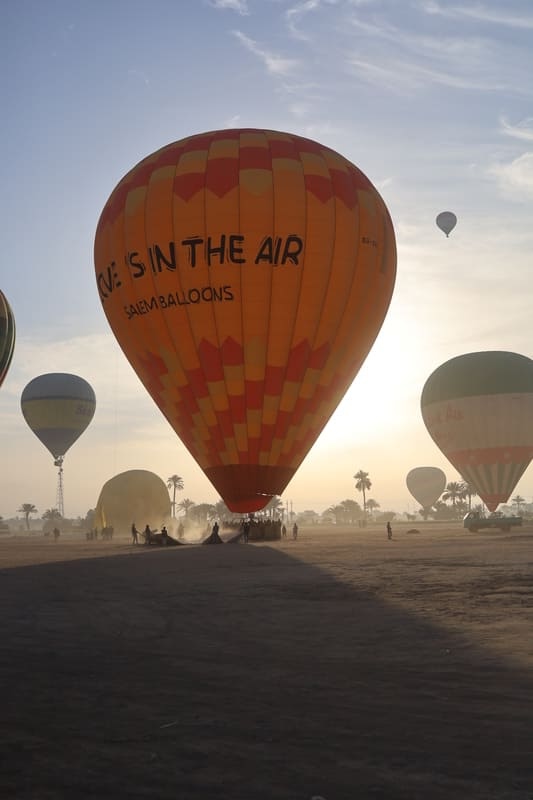
The ride itself was smooth and peaceful, giving us a completely different perspective of the area.
Seeing Hatshepsut’s Temple and the Nile River from above was really cool.
What stood out most was the contrast between the desert and the greenery—the way the farmlands abruptly met the sand was something you can’t fully appreciate from the ground.
We also floated over local villages with clay houses, offering a peek into daily life.
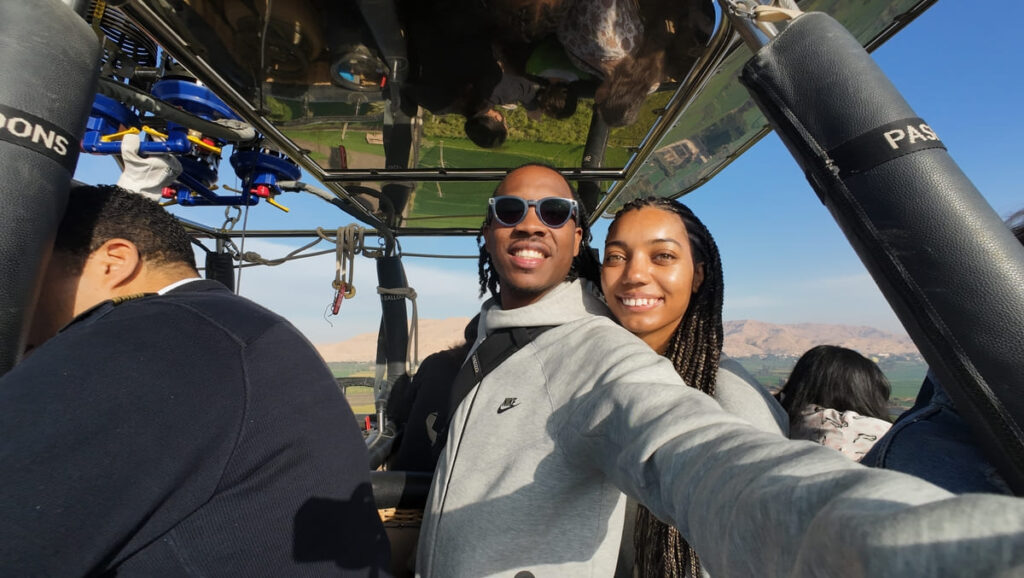
It was chilly in the morning, so we were glad we layered up. The balloon ride lasted about 45 minutes, and by 7:30 AM, we were back at the resort just in time for breakfast.
After the early start, breakfast at the Hilton was the perfect way to recharge before hitting the road again.
We hung out by the pool and admired the Nile River views until check-out time at 12 PM. Then it was time to head out to Aswan.
Drive from Luxor to Aswan
The drive from Luxor to Aswan took about 3 hours, and we paid around 2,500 EGP (~$50 USD) for a private ride.
Rates seem to vary, with some drivers quoting up to 4,000 EGP, so it’s worth negotiating in advance.
Just make sure the price includes any permits the driver needs to show at the police checkpoints along the way.
The scenery along the drive included desert, small villages, and the occasional Nile view, and it was nice to sit back and rest.
Staying in the Nubian Village
We chose to stay in the Nubian Village rather than Aswan’s main town, and it was 100% the right call.
The village was more laid-back and colorful.
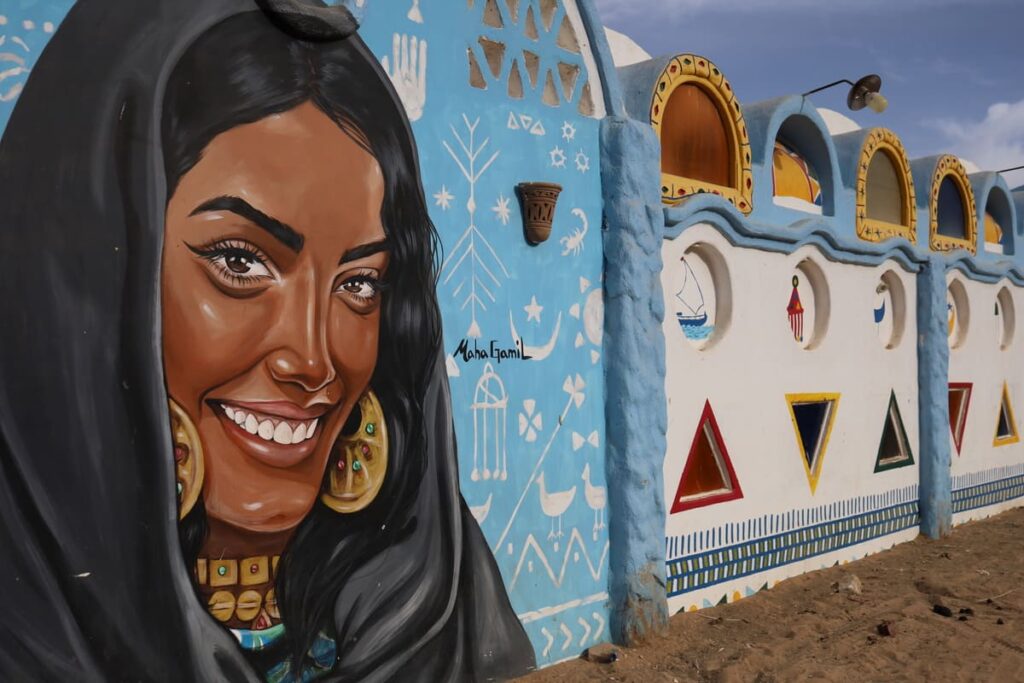
We stayed at Lawanda Nubian Guest House, which was in a prime location—right between two market streets and within walking distance of several restaurants.
For under $20 USD per night with breakfast included, it was easily one of the best-value stays of our entire Egypt trip.
When we checked in, the friendly manager welcomed us with a glass of Nubian hibiscus tea—the first of many hibiscus drinks we’d have that day.
And honestly, no complaints—hibiscus tea in Egypt just hits different.
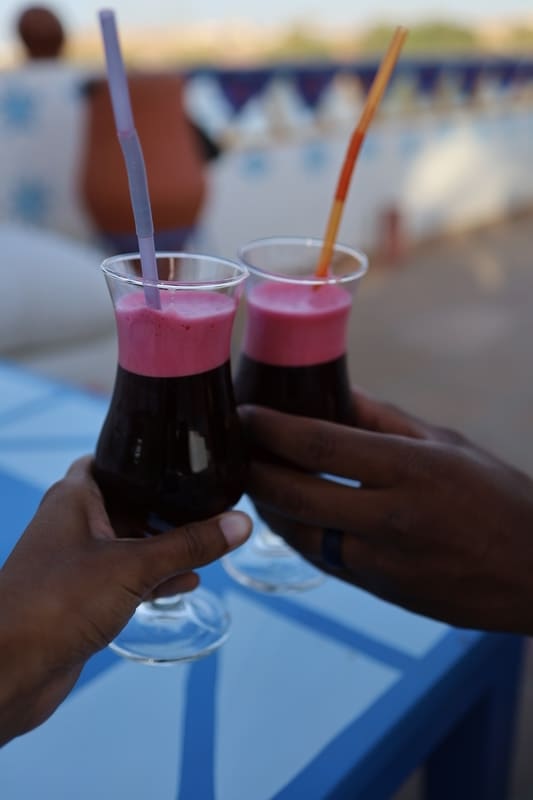
The manager also gave us local tips, like where to eat, which shops to go to, and what not to miss around the village.
The guest house itself was super artsy and colorful, with bright murals and intricate patterns covering the walls.
It felt like we were staying in a piece of artwork, not just a hotel. Our room was basic, clean, and comfortable.
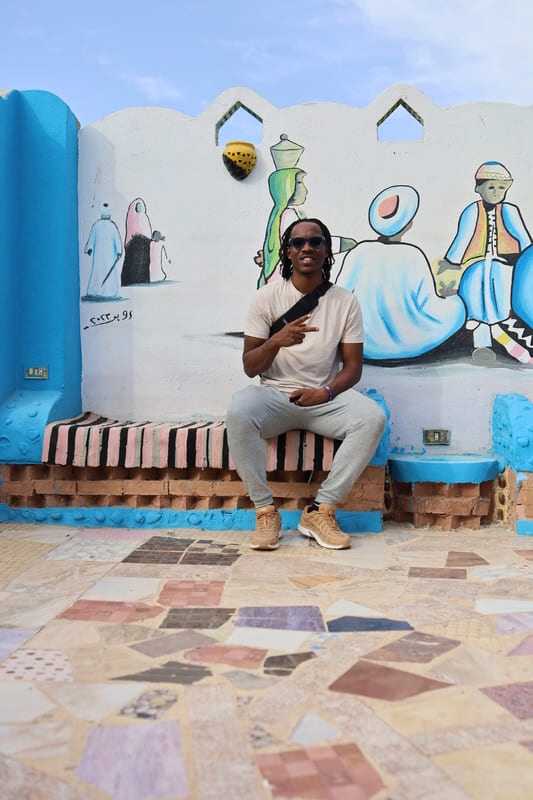
Nubian Village Markets
After settling in, we spent the afternoon wandering through the village’s markets.
Compared to the vendors in Cairo, the Nubian shopkeepers were more chill.
Don’t get me wrong—they still tried to lure us in and sell us things—but it didn’t feel nearly as pushy or aggressive. It was a bit more fun for us to browse through these markets.
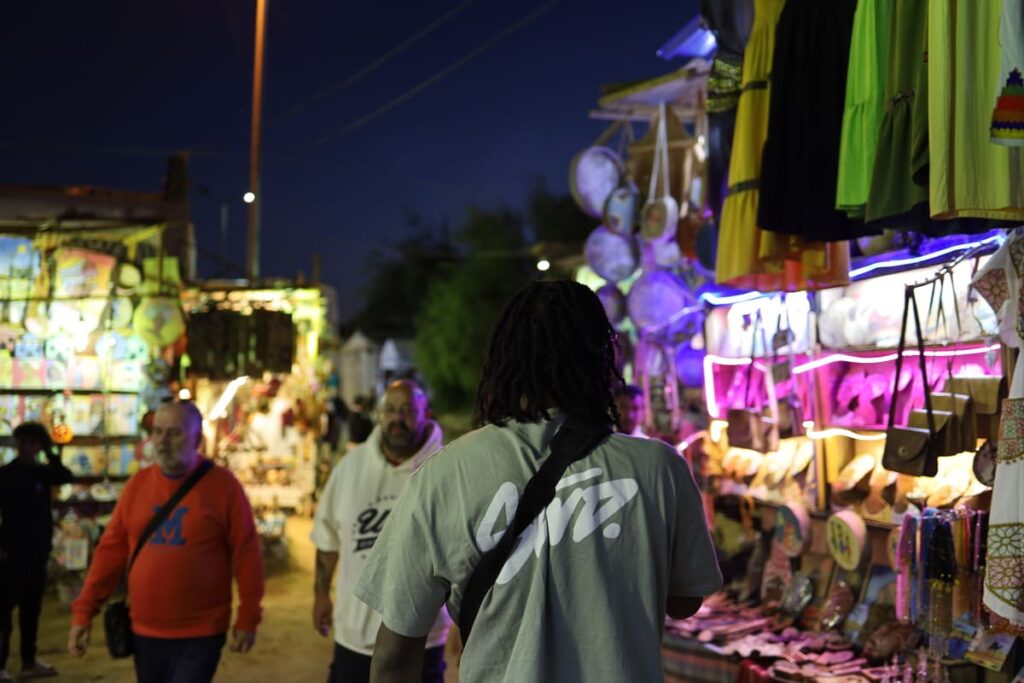
We strolled through colorful stalls selling:
- Handmade crafts – jewelry, scarves, and painted pottery
- Spices and herbs – bags of hibiscus, cumin, and saffron
- Local oils and perfumes – less intense sales pitches than in Cairo
Dinner at Dolty Kato Nubian House
For dinner, we went to Dolty Kato Nubian House, an open-air restaurant with relaxed vibes and views of the Nile.
The laid-back setting, paired with the gorgeous view over the river, made it the perfect dinner spot.
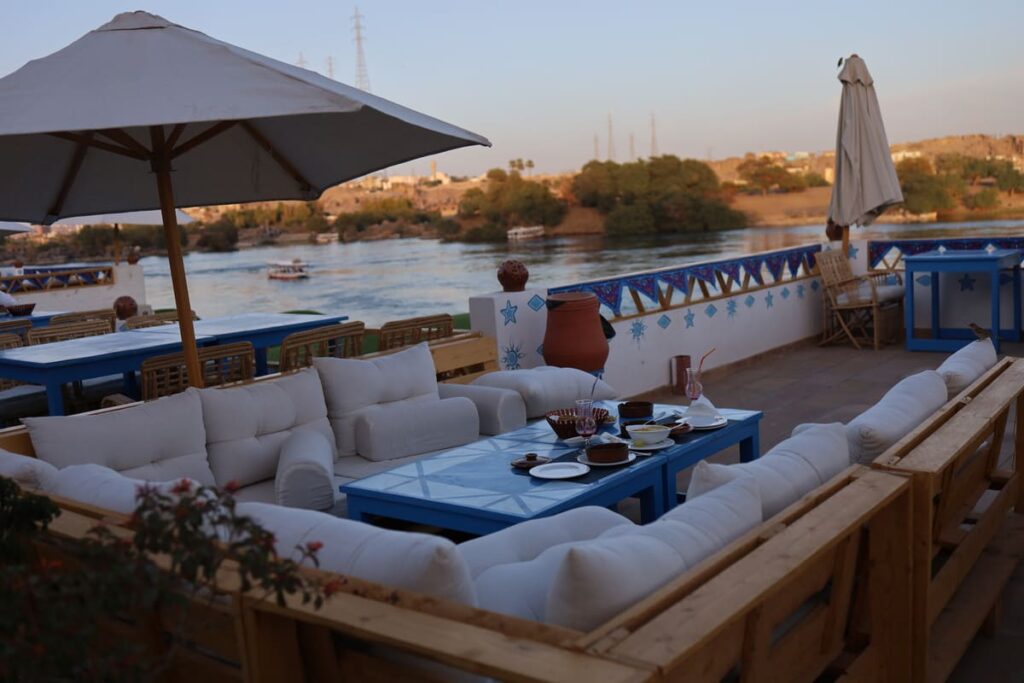
The food was flavorful and filling, with generous portions.
The menu had a mix of local dishes and familiar options, making it easy to find something we both liked, and only cost ~$18 USD total.
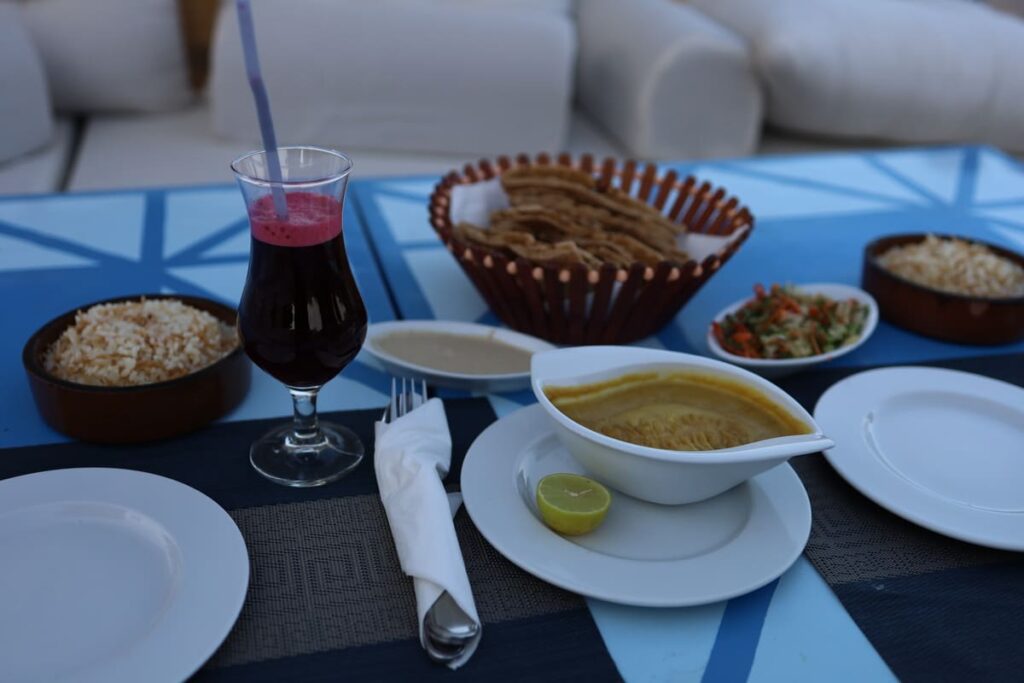
Sunset Tuktuk Ride to the Panoramic Viewpoint
After dinner, our waiter arranged a tuktuk ride for us to the panoramic viewpoint—and honestly, this was one of the highlights of the day.
For $10 USD, we had the most fun and lively ride through the village streets.
Our driver was full of personality, cracking jokes, honking, and waving at locals along the way.
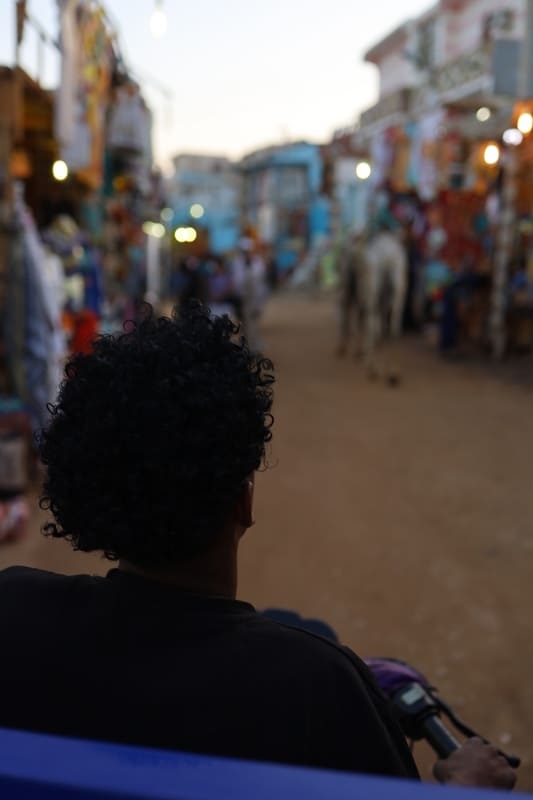
The ride took about 10-15 minutes and was definitely not walkable—most people take either a camel or a tuktuk to get up there.
Once we reached the top, the views were stunning.
On one side, we watched the sunset paint the sky with fiery hues, and on the other, we had panoramic views of the Nile River stretching into the distance.
Since it was Ramadan, our driver celebrated with fresh fruits and—you guessed it—another hibiscus tea, which he happily shared with us.
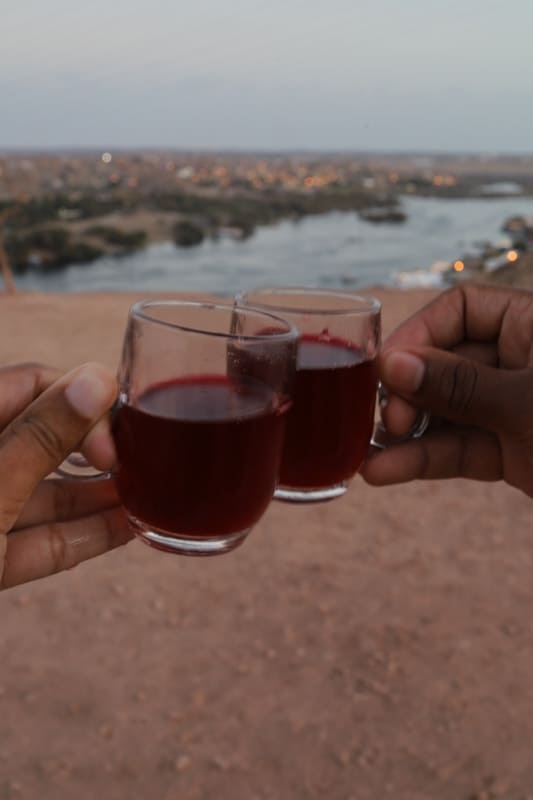
After sunset, we rode back through the Nubian Village in the tuktuk, passing through streets that were glowing with colorful lights.
The village had a lively but relaxed nighttime energy, with locals sitting outside their homes, chatting and sipping tea.
Day 6: Abu Simbel & Philae Temple
Early Breakfast at Lawanda Nubian Guest House
Even though we had an early morning start, our host at Lawanda Nubian Guest House was incredibly accommodating and prepared breakfast for us before we left.
It was such a thoughtful touch, especially considering how early it was. That level of hospitality made us love this stay even more.
Abu Simbel
We headed out around 4:30 AM on a group tour to Abu Simbel, which is about a 4-hour drive from Aswan.
Most tours leave at this time so you’ll arrive by 8:30 AM, explore for two hours, and head back around 10:30 AM.
While the convenience of the tour was nice, the crowds were overwhelming.
It was packed with hundreds of people from multiple tour groups, making it hard to fully take in the temples.
In hindsight, we wish we had hired a private driver and visited later in the morning to avoid the rush.
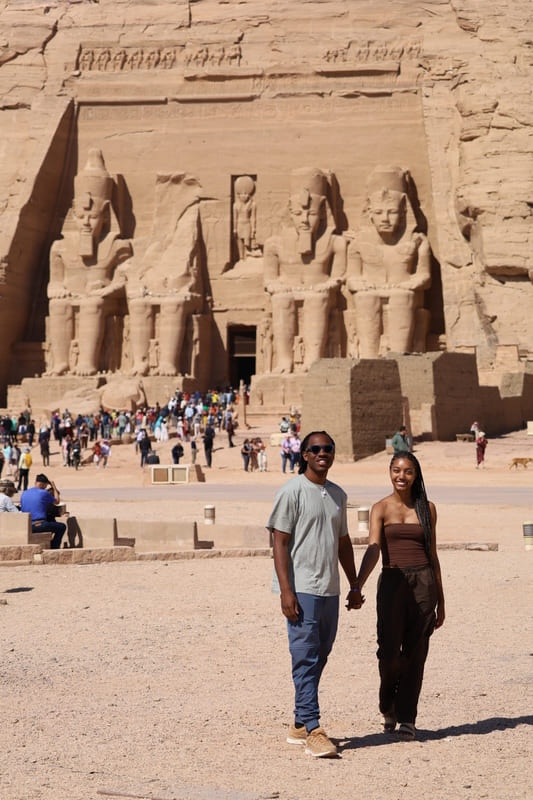
Most tours leave by 10:30 AM, so arriving afterward could give you a much quieter experience.
We paid around $25 USD per person for the group tour, but keep in mind that this only covered transportation.
There was no guide or temple explanation included. It was basically just a ride to and from the site.
Despite the crowds, Abu Simbel was still mind-blowing. The sheer scale of the temples is impossible to capture in photos.
The Great Temple of Ramses II is the first thing you’ll see, with its four colossal statues of Ramses II carved into the facade.
Standing about 66 feet (20 meters) tall, they’re absolutely massive.
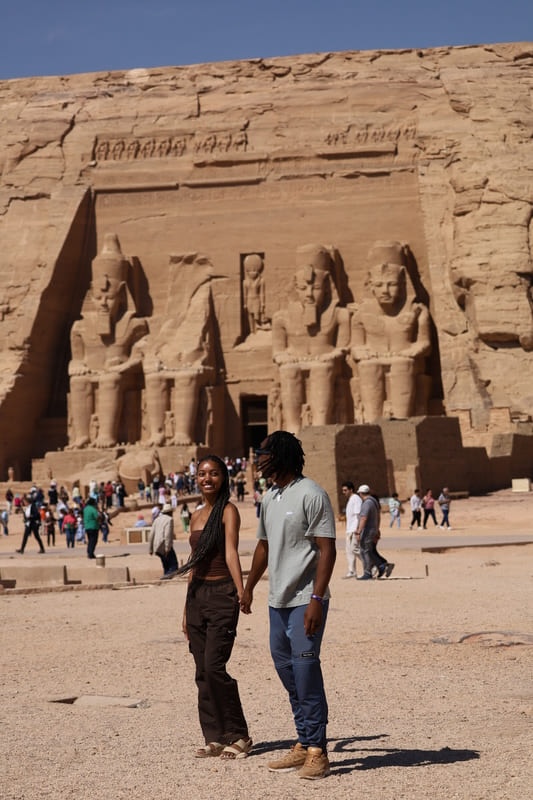
At the base of the statues are smaller figures of his children, which still tower over most people.
Right next to it is the Small Temple, which Ramses II dedicated to his wife Nefertari.
This one has six statues in front—four of Ramses and two of Nefertari.
Inside both temples, the hieroglyphics are incredibly intricate and detailed.
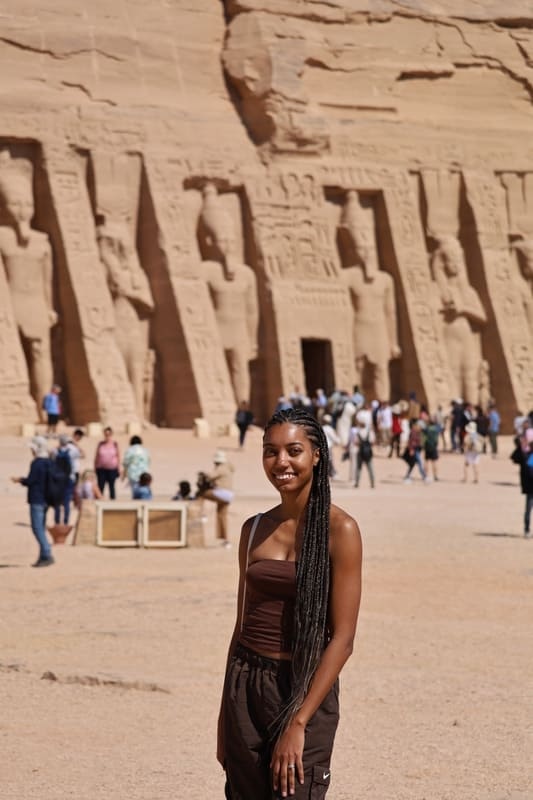
Outside, Abu Simbel overlooks Lake Nasser, the largest lake in Egypt.
What’s crazy is that this temple almost disappeared due to rising water levels after the construction of the Aswan High Dam.
To save it, the Egyptian government relocated the entire complex, moving it piece by piece to its current location.
Knowing what great care was taken to preserve it made us appreciate the site even more.
Philae Temple
After Abu Simbel, we could’ve returned to Nubian Village with the group, but instead, we got off at the Philae Temple stop to explore another incredible site.
What makes Philae Temple unique is that it sits on an island, so you have to take a boat across the water to reach it.
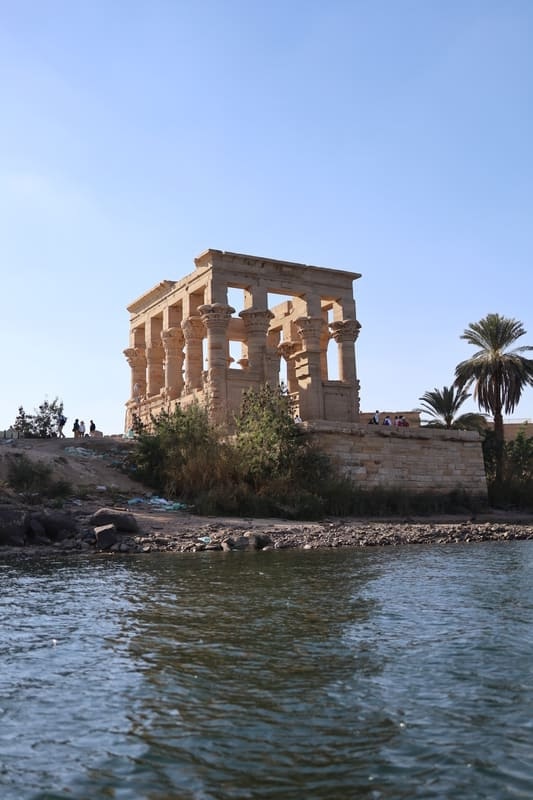
The entry fee was around 300 EGP (~$6 USD) per person to be paid with credit card only.
However, the boat ride is a separate cost to be paid by cash and can be negotiable.
Since the boats are rented privately, the fewer people onboard, the more you pay.
When we arrived, boat drivers initially quoted us 300-400 EGP(~$6 – $8 USD) per person for the round trip.
To cut the cost, we started looking around for other travelers to split the ride with.
Eventually, we found another couple and negotiated the boat fare down to 150 EGP (~$3 USD) per person round trip, with one hour at the temple.
If you can, it’s definitely worth waiting a few minutes to team up with other travelers and reduce the cost.
The boat ride itself was scenic, with clear views of the temple rising up from the water.
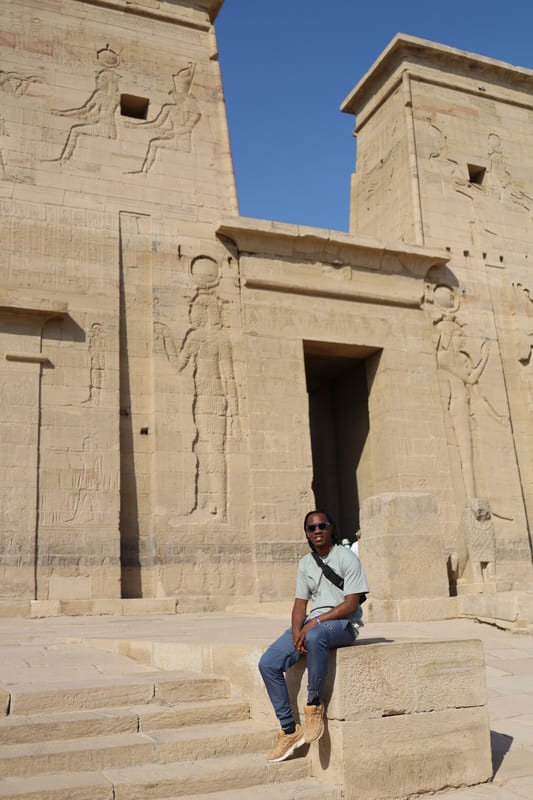
Philae is dedicated to Isis, the goddess of healing and motherhood, and the complex is beautifully preserved.
The columns and carvings are intricate, with hieroglyphics covering nearly every wall.
What stood out most was the tranquility of the site.
Since we arrived later in the day, the crowds were much smaller than at Abu Simbel, making it far easier to explore and appreciate the different temples on the island without feeling rushed.
Dinner at Doroka Nubian House
After Philae Temple, we headed back to Nubian Village.
We found a tuktuk with two other travelers heading in the same direction. Altogether, we paid 300 EGP (~$6 USD) for the 4 of us.
Once we made it back to Nubian Village, we were ready for a good meal.
We decided to try Doroka Nubian House, which is just a few buildings down from Dolty Kato.
The food was just as incredible, but Doroka was slightly more affordable.
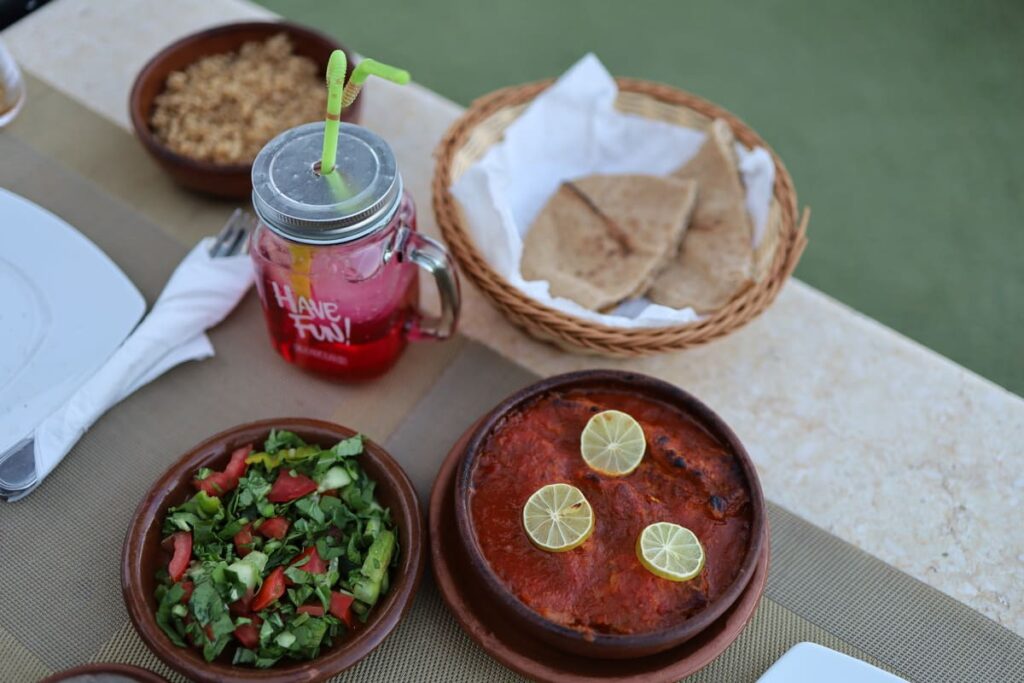
What made this dinner even better was that we had the entire place to ourselves.
It was quiet, peaceful, and felt super cozy, especially compared to the busier vibe at Dolty Kato.
We ordered a mix of local dishes, which were flavorful and filling.
Honestly, it felt like having a private dining experience—just us, great food, and a serene atmosphere that only cost ~$10 USD total.
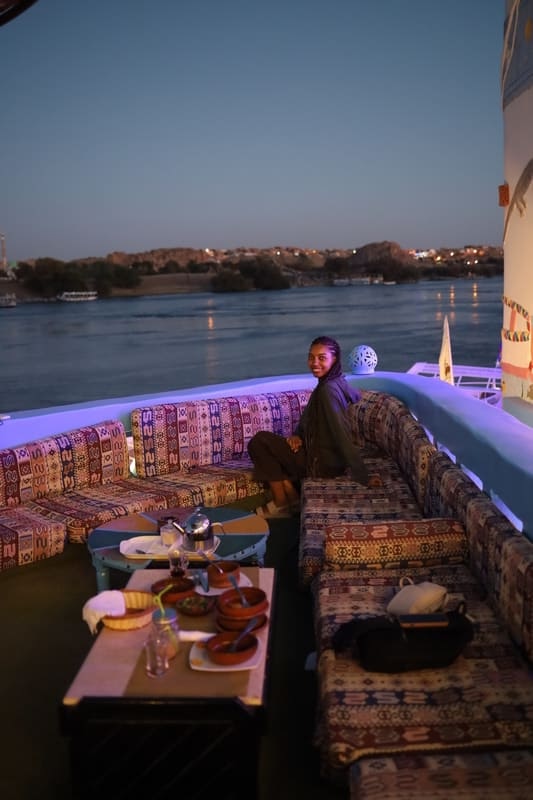
Day 7: Departure Day
We flew from Aswan to Cairo, which only took about an hour.
The flight was quick, comfortable, and well-worth the time saved compared to the long bus ride.
- Flight time: ~1 hour
- Cost: ~$47 USD per person (well worth it for the convenience)
If you’re on a tighter budget, you can take the bus, but be prepared for a 12-14 hour journey.
Unless you’re trying to save every last dollar, flying is definitely the better option.
Even though this is mainly a travel day, you can still squeeze in a bit more of Cairo if you have the time and energy before your departure.
Check out our full article to see what more you can do in less than 24 hours in Cairo.
Chew Tip: You can also find flights from Aswan to other international destinations, as Aswan Airport offers some direct flights to other countries.
Is 1 week long enough in Egypt?
A week in Egypt gives you just enough time to experience the highlights—Cairo, Luxor, Aswan, and Abu Simbel—but it’s definitely not enough to see it all.
If you have more than a week in Egypt, it’s worth venturing beyond the major cities.
- For beach and water lovers: Add Hurghada or Sharm El Sheikh for diving, snorkeling, and beach resorts.
- For nature and offbeat experiences: Visit Siwa Oasis or Al Fayoum for desert landscapes and local life.
- For history buffs: Head to Alexandria or Saqqara for ancient wonders beyond the usual tourist trail.
Even with just a week, you’ll only scratch the surface of Egypt’s incredible history and culture.
If you can, consider adding a few extra days to explore more of its diverse landscapes and experiences.
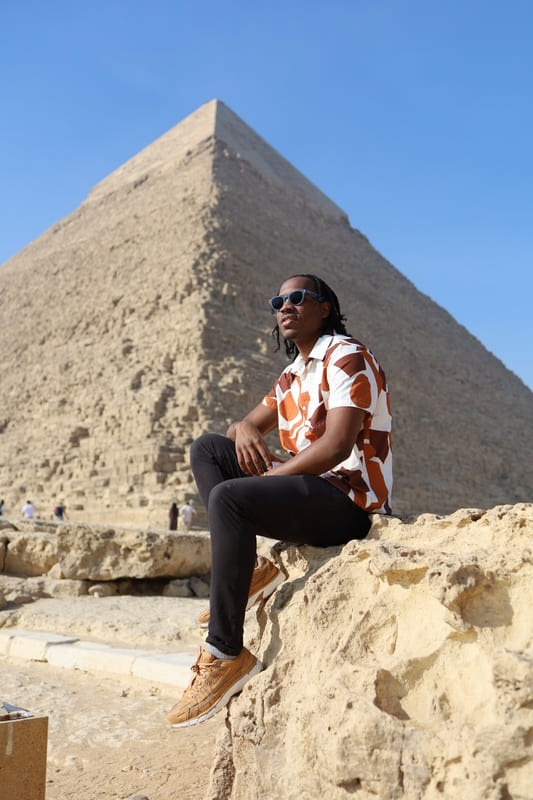
Egypt FAQs
How many days do I need in Egypt?: A week is enough to see highlights like Cairo, Luxor, and Aswan, but 10-14 days allows for a deeper experience, including the Red Sea and lesser-known sites.
What is the best itinerary for Egypt?: A popular 7-day itinerary includes Cairo (Pyramids, Sphinx, Museum), Luxor (Valley of the Kings, Karnak Temple), and Aswan (Abu Simbel, Philae Temple).
Is Egypt cheap or expensive?: Egypt is generally affordable, especially for food, transportation, and attractions. Luxury options can be pricey, but budget travelers can get great value.
Is it safe to travel to Egypt right now?: Yes, most tourist areas are safe, but it’s wise to stay aware of local news and follow travel advisories.
Do I need a visa for Egypt?: Yes, US citizens need a visa. You can get one on arrival for $25 USD (cash only).
What is the best month to visit Egypt?: The best time is from October to April when temperatures are cooler and more comfortable for sightseeing.
Found this article helpful? Share it!

